yPS細胞と錯視
2010年8月7日より
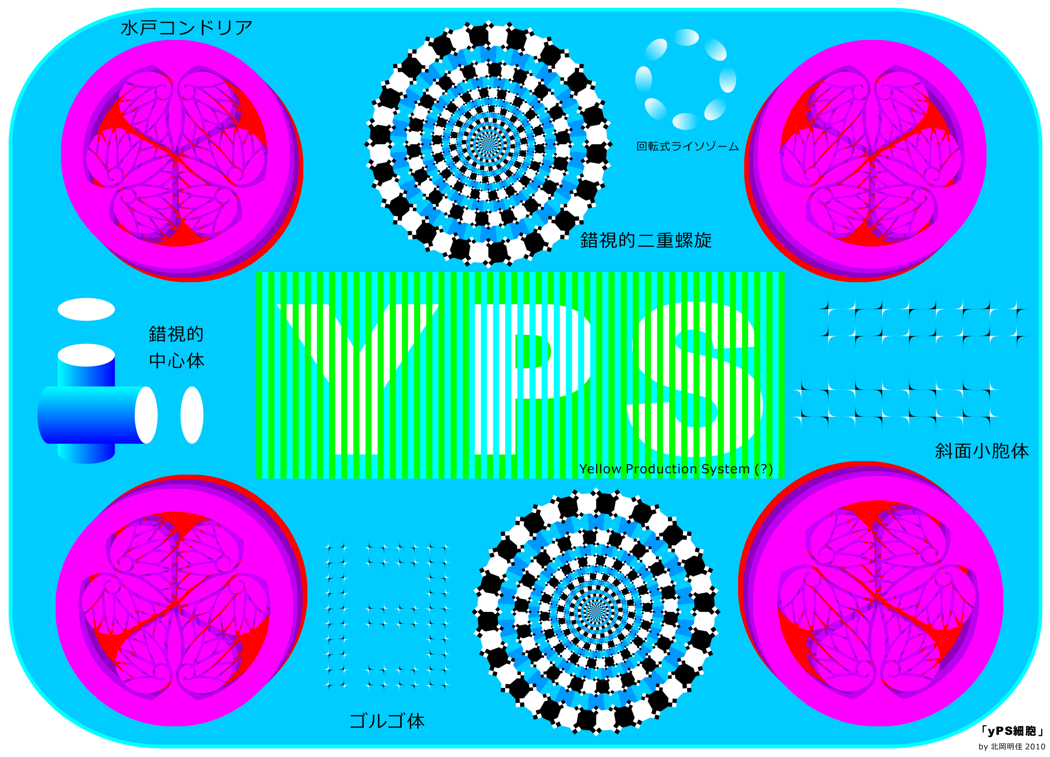
「yPS細胞」
2010年の第38回YPS(九州大学大学院芸術工学府 視覚心理学研究室 YPS実行委員会主催)の講演のタイトルを「yPS細胞と錯視」としてしまったために、期日も迫ってあわてて作り上げた錯視てんこ盛り作品。YPSとは、Young Perceptionists' Seminar の略である。「知覚心理学会」の若手版といったところであるが、伝統がある。自称若手も参加できる。合宿形式で、「妄想発表」を主体とする。以下、本作品の錯視の説明を行なう。
「水戸コンドリア」 ・・・ 4隅に配した葵の御紋が図の中心から遠ざかる方向に動いて見える。(最適化型フレーザー・ウィルコックス錯視 タイプ V)
「錯視的二重螺旋」 ・・・ 同心円配列したパターンが渦巻きに見える。(縁飾りエッジの錯視の渦巻き錯視) 目を動かすたびに円盤が急速に回転して見える。回転して見える方向は不定。(リフレッシュ依存の回転錯視)
「回転式ライソゾーム」 ・・・ リングはゆっくり時計回りに回転して見える。(中心ドリフト錯視)
「錯視的中心体」 ・・・ 白い楕円は円筒の上部として知覚されるとずんぐりして見える。逆に言い方をすると、円筒の上部の楕円を切り離して取り出すと細長く見える。(シェパード錯視)
「Yellow Production System (?)」 ・・・ Y と S は黄色く見えるが、物理的には P の白と同じである。(ムンカー錯視)
「斜面小胞体」 ・・・ 上の列は左に傾いて見え、下の列は右に傾いて見えるが、物理的にはどちらも水平に並んでいる。(トゲトゲドリフト錯視の傾き錯視) 網膜像の動きに依存して、これらのパターンは動いて見える。(トゲトゲドリフト錯視)
「ゴルゴ体」 ・・・ 1は左に傾いて見え、3は右に傾いて見えるが、物理的にはどちらも垂直・水平に配列している。(トゲトゲドリフト錯視の傾き錯視のうちツェルナー錯視) 網膜像の動きに依存して、これらのパターンは動いて見える。(トゲトゲドリフト錯視)
Copyright Akiyoshi Kitaoka 2010 (August 9)
<Handout>
本日の妄想(本日のメニュー)
1. 色の錯視
2. 最適化型フレーザー・ウィルコックス錯視
3. 渦巻き錯視
4. 同居性の傾き錯視&動く錯視
5. 遠近法的錯視
1. 色の錯視

「YPS黄信号」
上のブロックと下のブロックの Y と S は黄色く見えるが、物理的にはPの白と同じである。中のブロックでは、P が黄色く見えるが、物理的には Y や S の白と同じである。
Copyright Akiyoshi Kitaoka 2010 (August 7)
"Good complexion illusion"
Pale complexion can be improved by color assimilation and contrast.
Copyright Akiyoshi .Kitaoka 2007 (March 10)
(Colour assimilation)
"School entrance ceremony"
Although sakura are drawn with gray, they appear to be tinted pink.
Copyright Akiyoshi .Kitaoka 2007 (March 2)
You can confirm that the petals are really gray if you place the cursor on the image.
(Colour contrast)
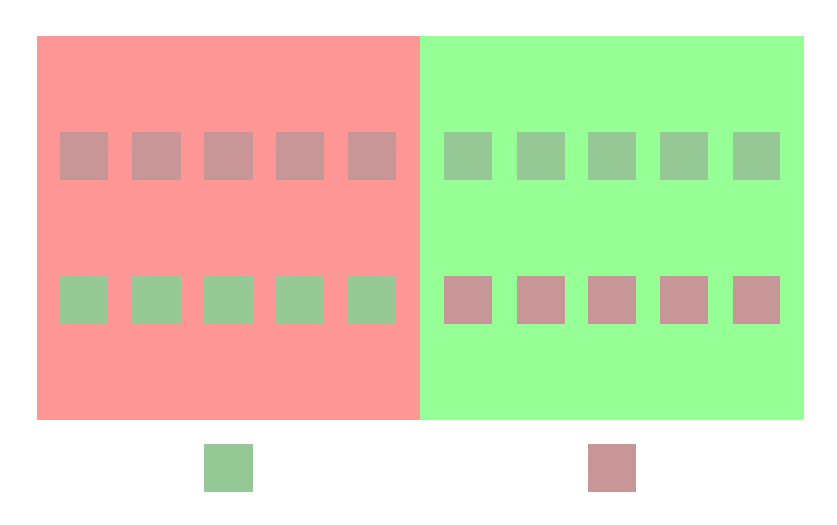
"Sakai's color contrast"
The squares of the upper row appear to be gray, but they are tinted as shown in the lower row that exchanges between the left fives and the right fives. This illusion is based upon a finding of Kasumi Sakai's graduational thesis (2003, Department of Psychology, Ritsumeikan University) entitled "Color representation by Land's retinex theory and Belsey's hypothesis" (in Japanese).
Copyright A.Kitaoka 2002
(Colour contrast or colour constancy)
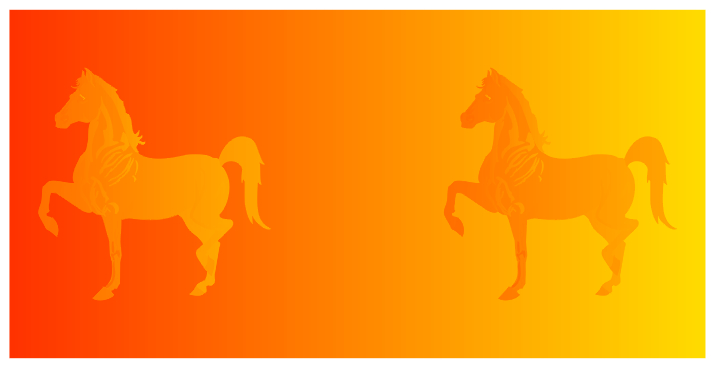
"Horses"
It appears as if there were a yellow horse and a red one, but they are identical in color actually.
Copyright Akiyoshi Kitaoka 2005 (August 18) (using a clipart provided by CoreDRAW 9)
(Colour constancy)

"Four areas"
The leftmost square is physically the same colour (gradient) as the neighboring one and the rightmost square is the same colour as the neighboring one, though they do not appear so.
Copyright Akiyoshi Kitaoka 2006 (May 1)
(Colour constancy)

Copyright Akiyoshi .Kitaoka 2009 (September 22)
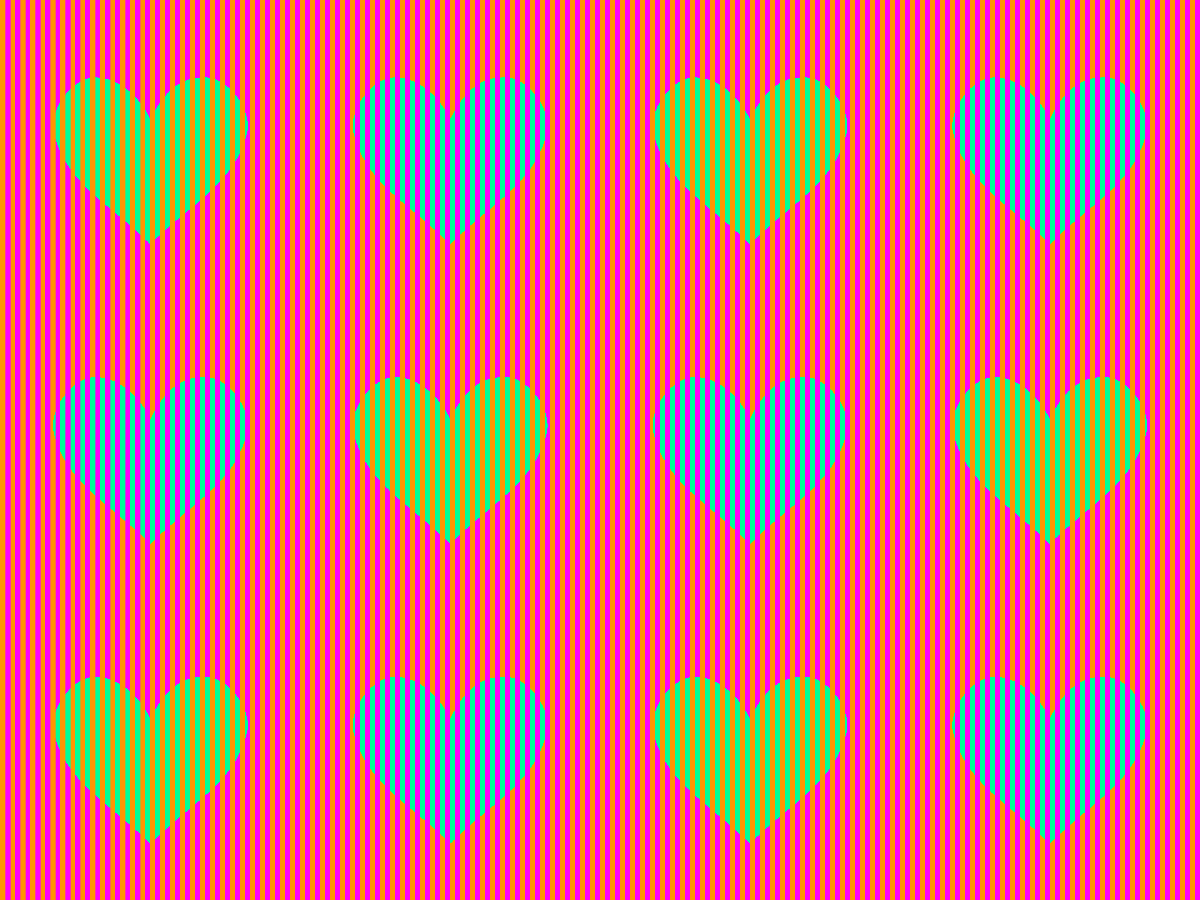
"Striped green
and blue hearts"
There appear to be hearts of light green or light blue. Actually, they are identical (R=0, G=255, B=150).
Copyright Akiyoshi Kitaoka 2009 (May 24)
(Chromatic White's effect)
"The ground family"
The left pigeon appears to be yellowish, but the color is the same white as the right.
Copyright Akiyoshi .Kitaoka 2007 (March 12)
(Chromatic White's effect)
"Guruguru 6"
There appear to be two different colors in inner rings, though they are the same as each other.
Copyright Akiyoshi .Kitaoka 2007 (January 15)
(Colour assimilation and remote colour contrast)
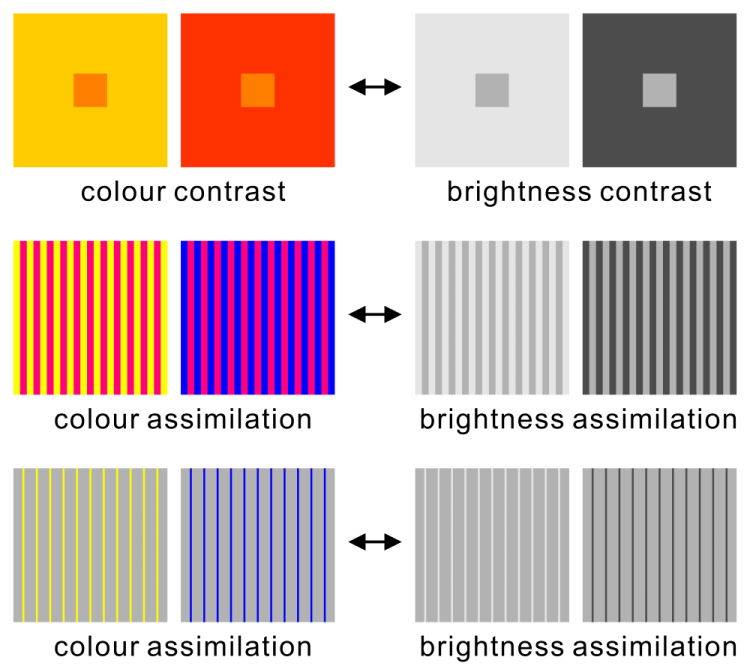
White's illusion
White, M. (1979) A new effect on perceived lightness. Perception, 8, 413-416.
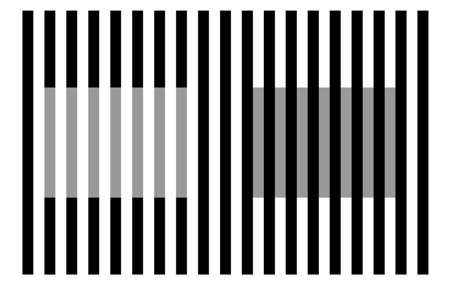
The left gray grating appears to be lighter than the right one, though they are the same luminance.
The chromatic White's illusion is possible. It is Munker's illusion.
Munker, H. (1970) Farbige Gitter, Abbildung auf der Netzhaut und ubertragungstheoretische Beschreibung der Farbwahrnehmung. Habilitationsschrift, Ludwig-Maximilians-Universität, München.
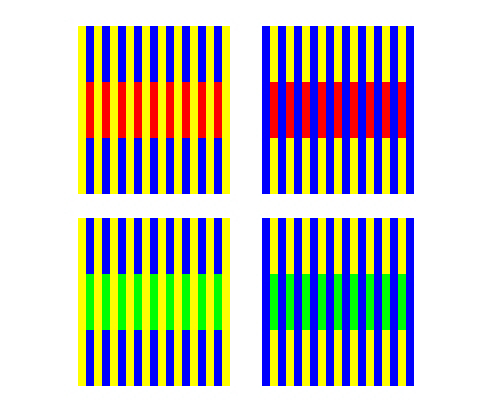
The orange and magenta gratings shown in the upper row are actually the same red, and the yellowish-green and cyan gratings displayed in the lower row are the same green.
White (1982) proposed another lightness illusion without T-junctions "White's dotted lightness illusion".
White, M. (1982) The assimilation-enhancing effect of a dotted surround upon a dotted test region. Perception, 11, 103-106.
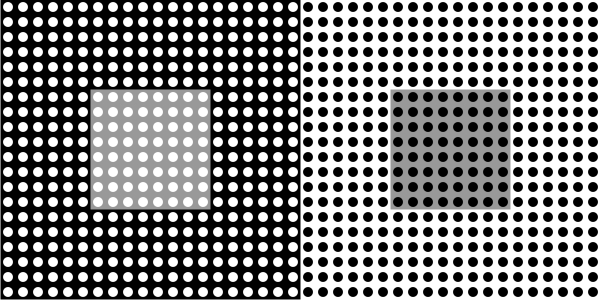
The left gray grating appears to be lighter than the right one, though they are the same luminance.
White's dotted colour illusion is possible.
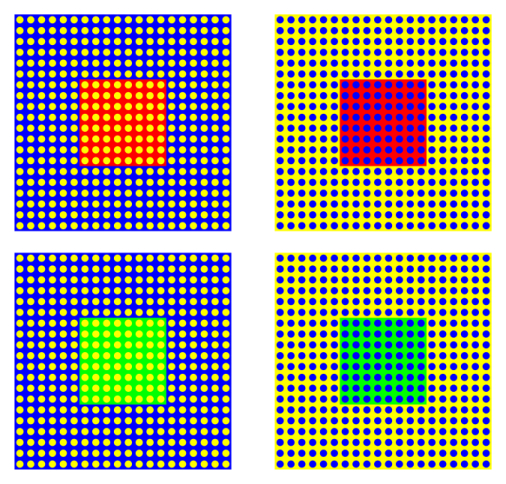
The orange and magenta squares shown in the upper row are actually the same red, and the yellowish-green and cyan squares displayed in the lower row are the same green.
I think the dungeon illusion (Bressan, 2001) and the De Valois-De Valois
illusion are essentially the same illusion as the two White's illusions.
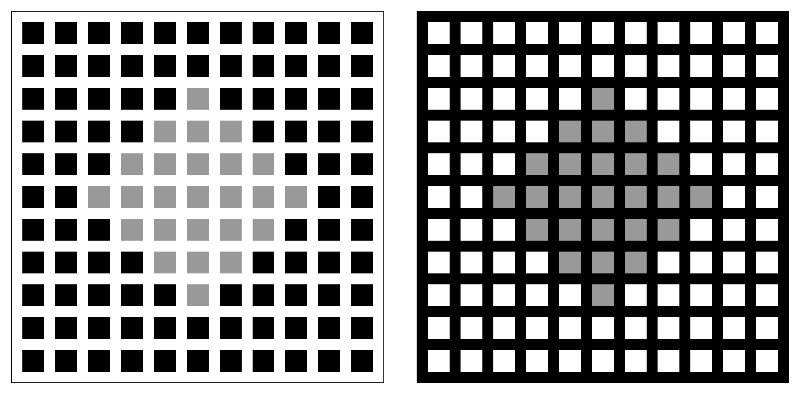
dungeon illusion (Bressan's illusion)
Bressan, P. (2001) Explaining lightness illusions. Perception, 30, 1031-1046.
The left gray squares appear to be lighter than the right ones, though they are the same luminance.
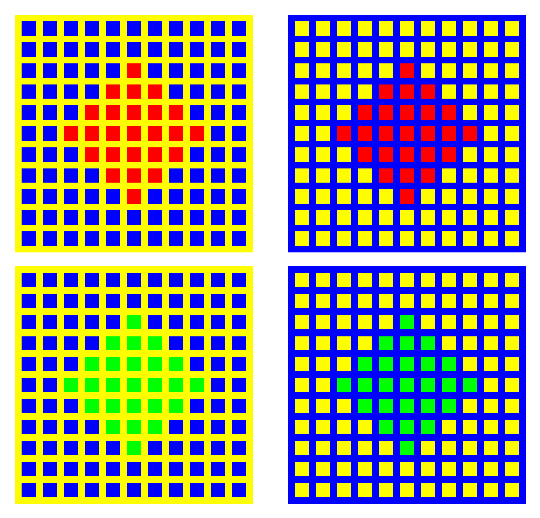
chromatic dungeon illusion
The orange and magenta squares shown in the upper row are actually the same red, and the yellowish-green and cyan squares displayed in the lower row are the same green.
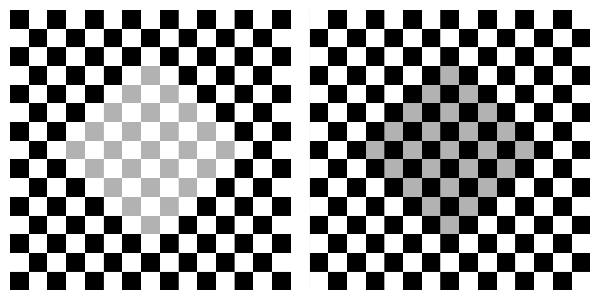
De Valois-De Valois illusion, achromatic version
De Valois, R. L. and De Valois, K. K. (1988) Spatial Vision. New York: Oxford University Press.
The left gray squares appear to be lighter than the right ones, though they are the same luminance.
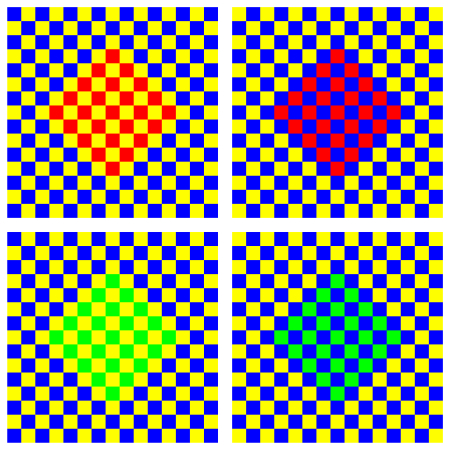
De Valois-De Valois illusion, chromatic version
De Valois, R. L. and De Valois, K. K. (1988) Spatial Vision. New York: Oxford University Press.
The orange and magenta squares shown in the upper row are actually the same red, and the yellowish-green and cyan squares displayed in the lower row are the same green.
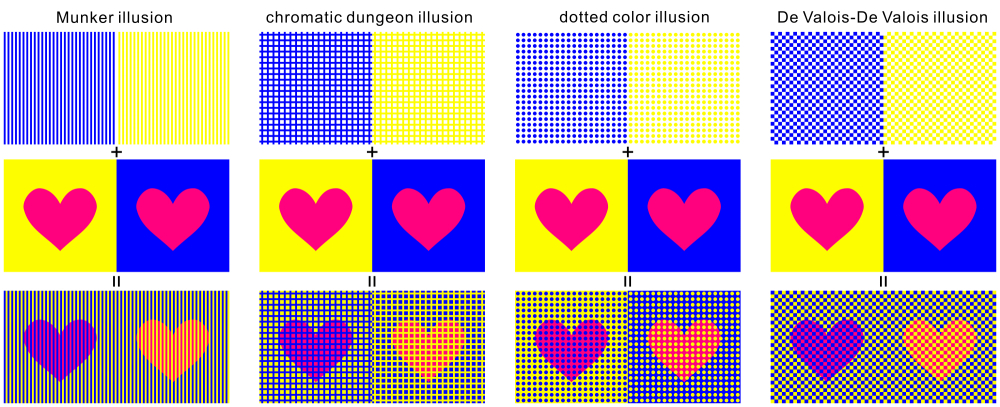
"How to make the four types of color illusions"
Hearts of the same color (R=255, G=0, B=127) appear to be pink or orange, induced by the Munker illusion, the chromatic dungeon illusion, the dotted color illusion, and the De Valois-De Valois illusion. To download high-resolution files, click here (8000 x 3262 pixel, 10MB)
Copyright Akiyoshi Kitaoka 2009 (June 1)
References
| Munker illusion | Munker, H. (1970) Farbige Gitter, Abbildung auf der Netzhaut und übertragungstheoretische Beschreibung der Farbwahrnehmung. Habilitationsschrift, Ludwig-Maximilians-Universität, München. |
| chromatic dungeon illusion | For the dungeon illusion: Bressan, P. (2001) Explaining lightness illusions.
Perception, 30, 1031-1046. Kitaoka (2007) http://www.psy.ritsumei.ac.jp/~akitaoka/saishin22e.html |
| dotted color illusion | For the dotted brightness illusion: White, M. (1982) The assimilation-enhancing effect of a dotted surround upon a dotted test region. Perception, 11, 103-106. Kitaoka (2008) http://www.psy.ritsumei.ac.jp/~akitaoka/color10e.html |
| De Valois-De Valois illusion | De Valois, R. L. and De Valois, K. K. (1988) Spatial Vision. New York: Oxford University Press. |
cf.
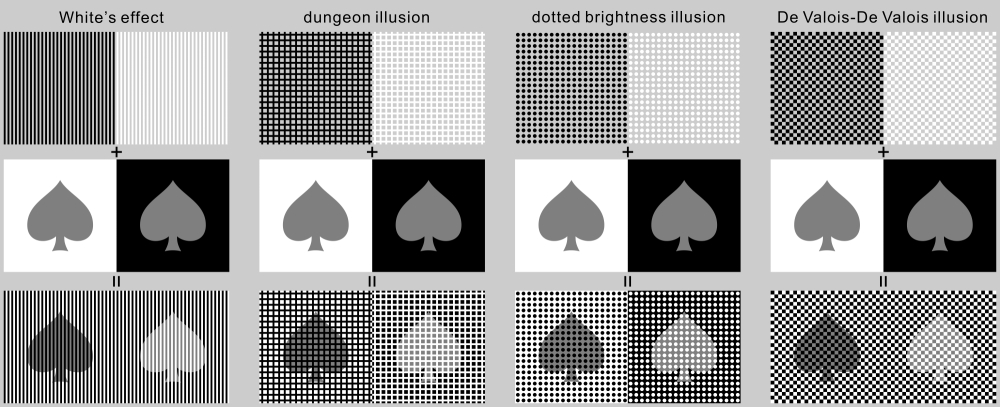
"How to make the four types of brightness/lightness illusions"
Spades of the same brightness (R=127, G=127, B=127) appear to be darker or brighter, induced by White's effect, Bressan's dungeon illusion, White's dotted brightness illusion, and the De Valois-De Valois illusion. To download high-resolution files, click here (8000 x 3262 pixel, 5MB)
Copyright Akiyoshi Kitaoka 2009 (June 1)
References
| White's effect (White's illusion) | White, M. (1979) A new effect on perceived lightness. Perception, 8, 413-416. |
| dungeon illusion | Bressan, P. (2001) Explaining lightness illusions. Perception, 30, 1031-1046. |
| dotted brightness illusion | White, M. (1982) The assimilation-enhancing effect of a dotted surround
upon a dotted test region. Perception, 11, 103-106. |
| De Valois-De Valois illusion | De Valois, R. L. and De Valois, K. K. (1988) Spatial Vision. New York: Oxford University Press. |
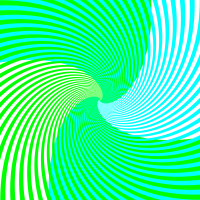 These illusions show a good correspondence between colour and lightness.
These illusions show a good correspondence between colour and lightness.
More info
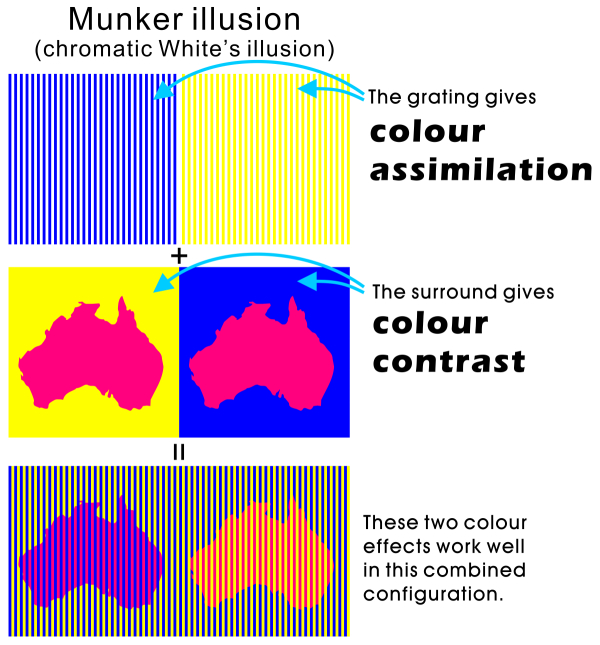
Left: Blue (assimilation) + Blue (contrast of yellow) = Blue induction; Right: Yellow (assimilation) + Yellow (contrast of blue) = Yellow induction
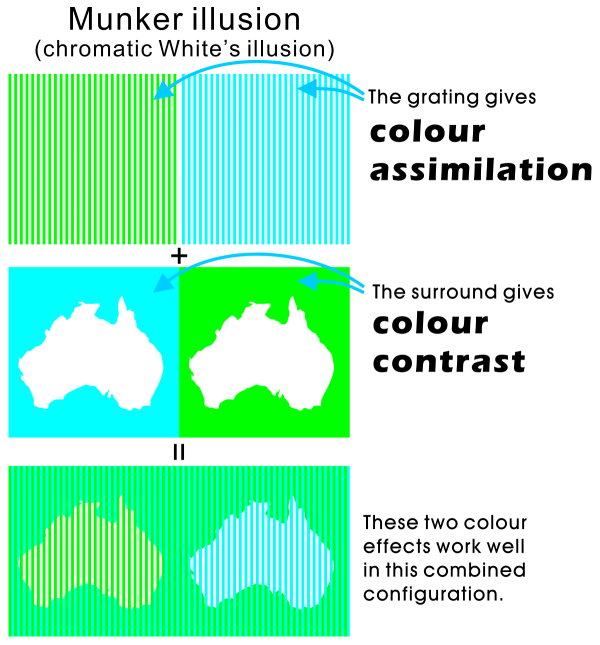
Left: Green (assimilation) + Red (contrast of cyan) = Yellow induction; Right: Cyan (assimilation) + Magenta (contrast of Green) = Blue induction
 OK?
OK?
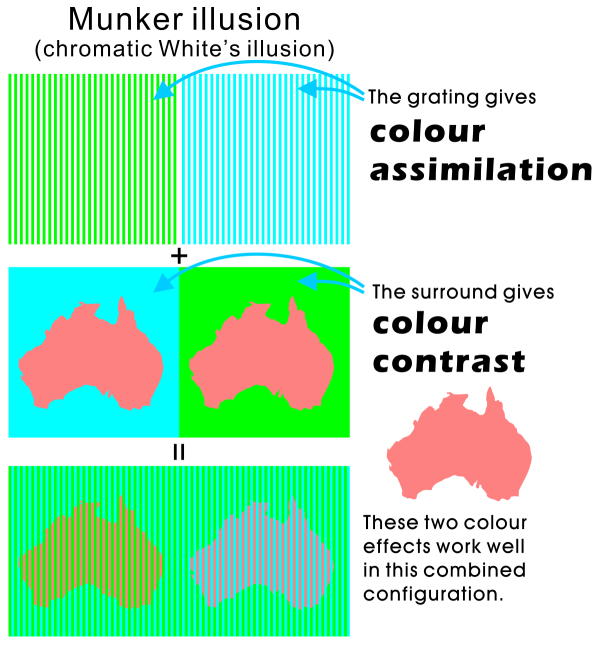
Left: Green (assimilation) + Red (contrast of cyan) + Light Red = Light Orange; Right: Cyan (assimilation) + Magenta (contrast of Green) + Light Red = Light Magenta
2. 最適化型フレーザー・ウィルコックス錯視

「葵の御紋の回転」
4つの葵の御紋全体が時計回りに回転して見える。
Copyright Akiyoshi Kitaoka 2010 (August 7)
§3. A speculation of the "Rotating snakes" illusion
(Optimized Fraser-Wilcox illusion)
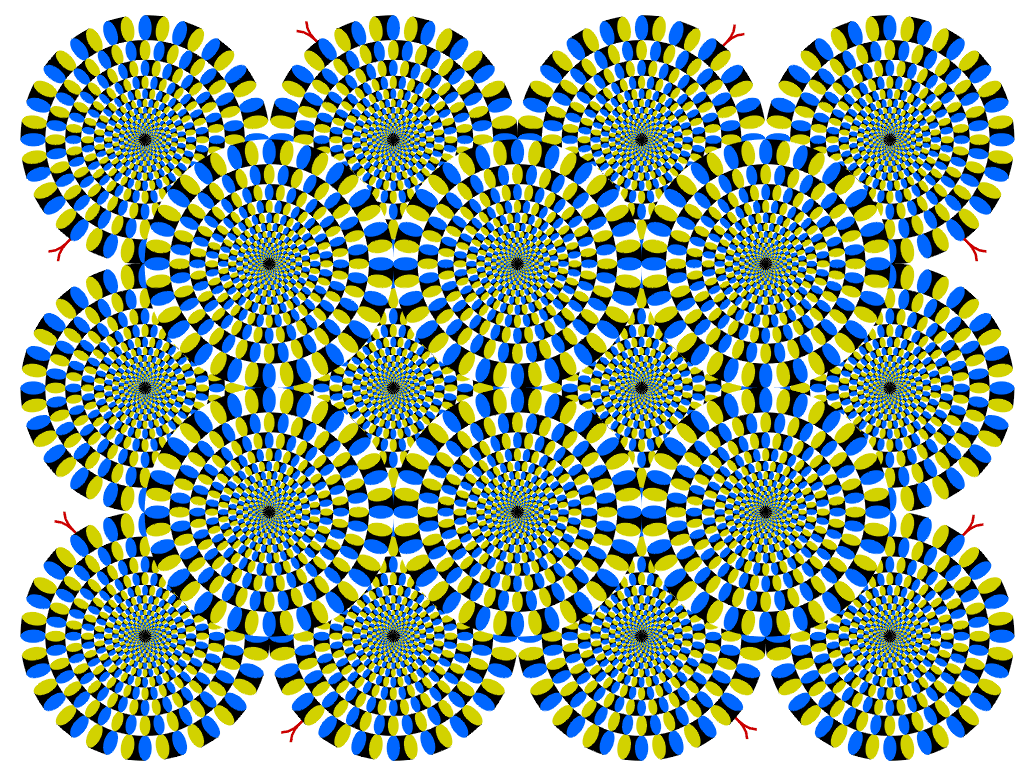
"Rotating snakes"
Circular snakes appear to rotate 'spontaneously'.
Copyright A.Kitaoka 2003 (September 2, 2003)
Explanation of the
elemental illusion (optimized Fraser-Wilcox illusion)
(PDF)
How this
work was created (PDF) (Trick Eyes Graphics
p.78)
The commercial use of this image is not free of charge. Modification of this image for commercial purpose is usually declined. Educational or research use or modification is welcome.
The general rule of motion direction
black → dark-gray → white → light-gray → black
Optimized Fraser-Wilcox illusion, Type I
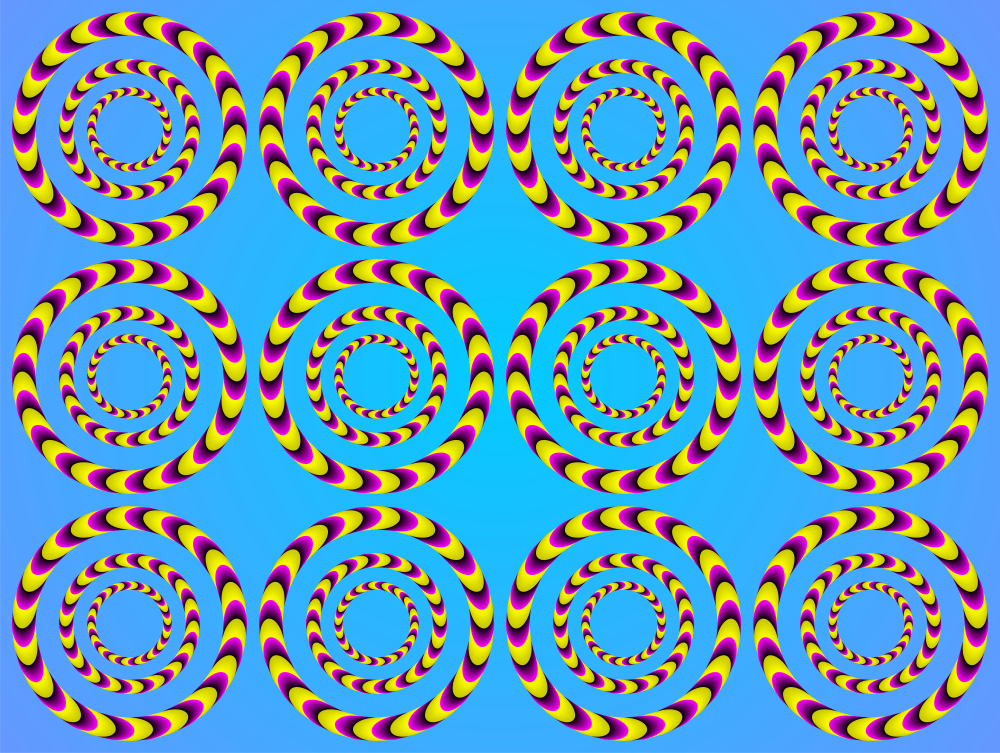
"Pack of rotating red
snakes"
Rings appears to rotate slowly or quickly.
Copyright Akiyoshi Kitaoka 2008 (March 19)
Optimized Fraser-Wilcox illusion, Type IIa
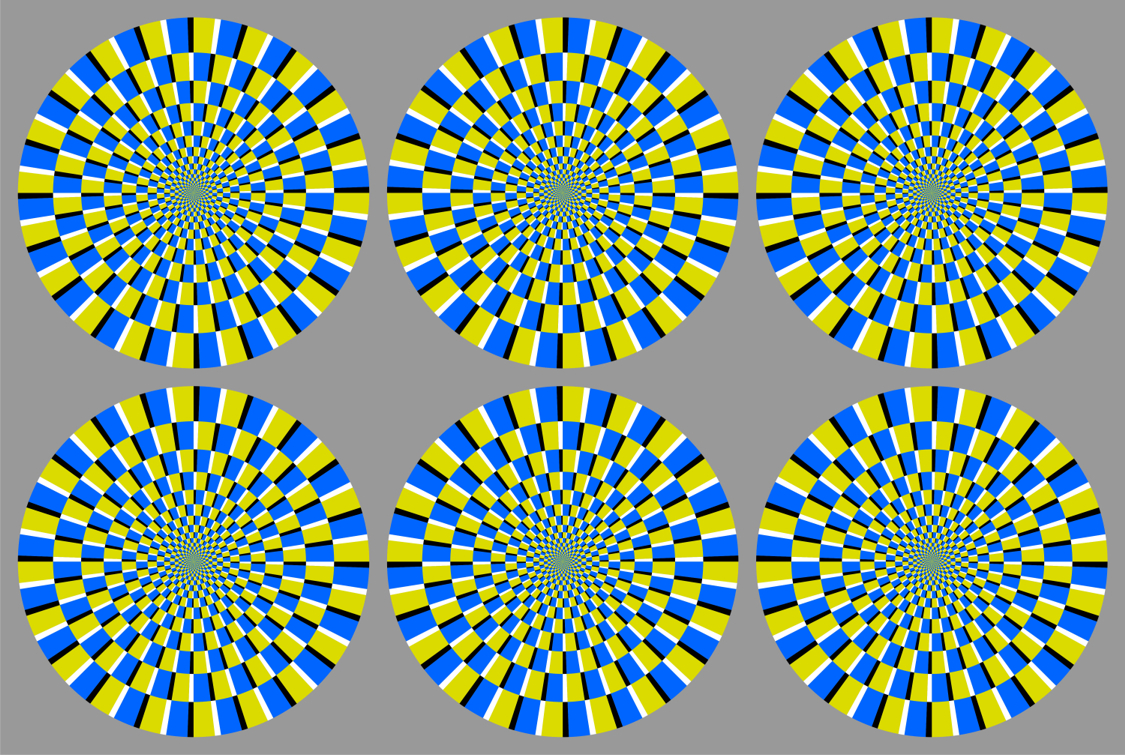
Optimized Fraser-Wilcox illusion, Type III
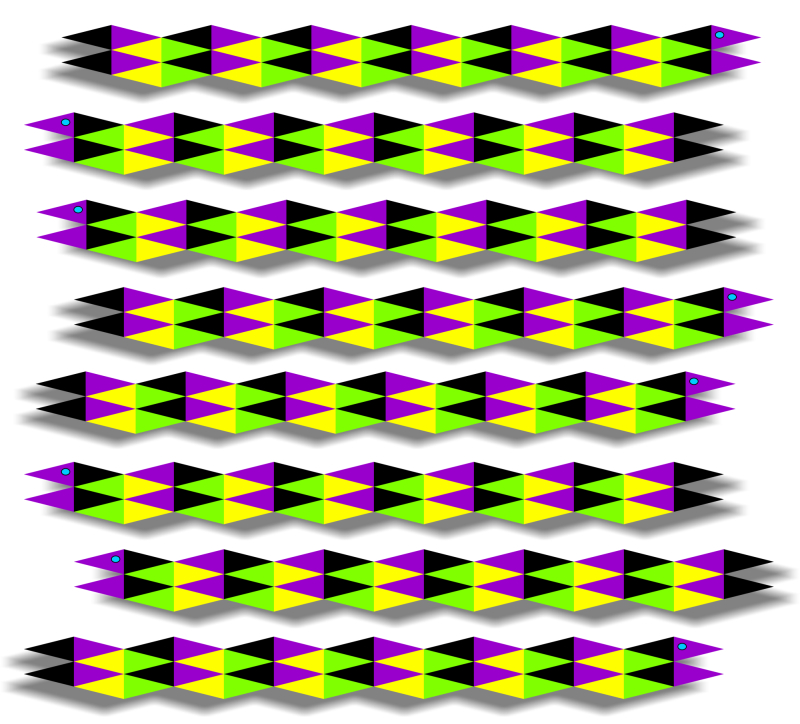
"Moving snakes with
shadows"
Snakes appear to move horizontally.
Copyright Akiyoshi Kitaoka 2009 (June 7)
Optimized Fraser-Wilcox illusion, Type III
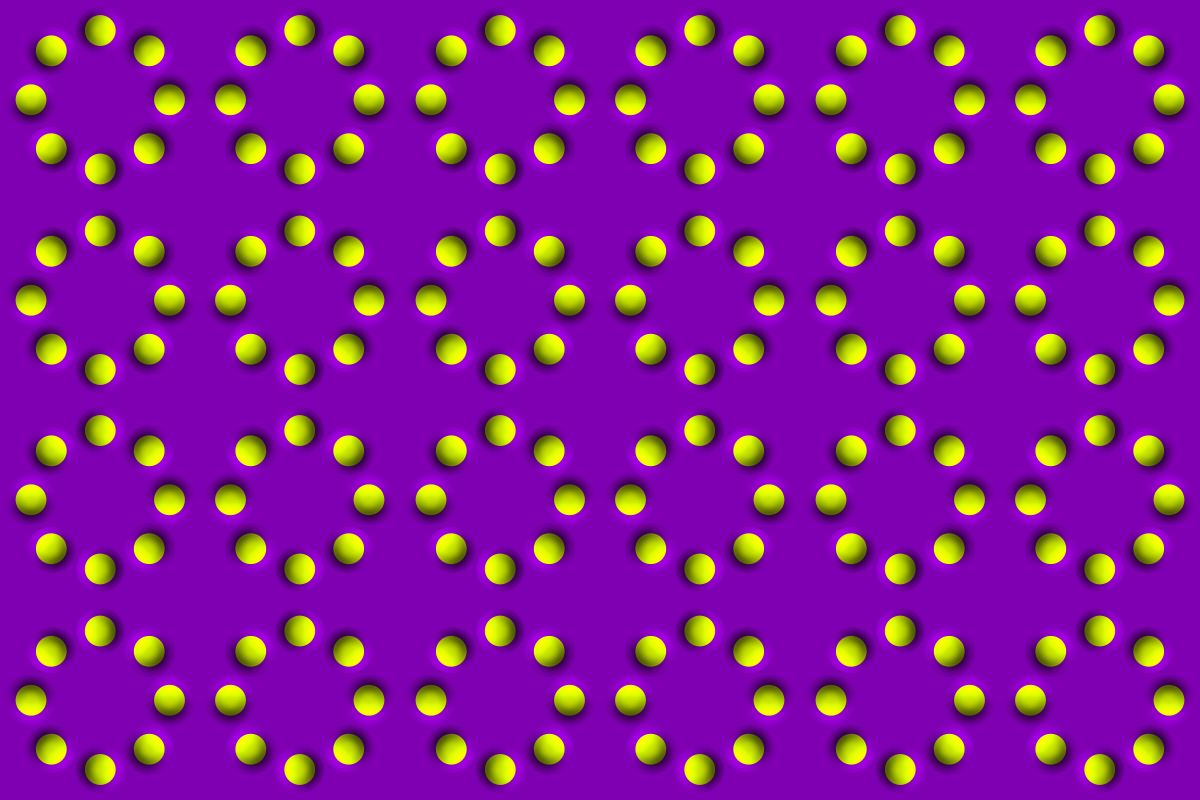
"Rotating
tablets"
(an abundant version)
Rings of tablets appear to rotate.
Copyright Akiyoshi Kitaoka 2009 (March 25)
Optimized Fraser-Wilcox illusion, Type V
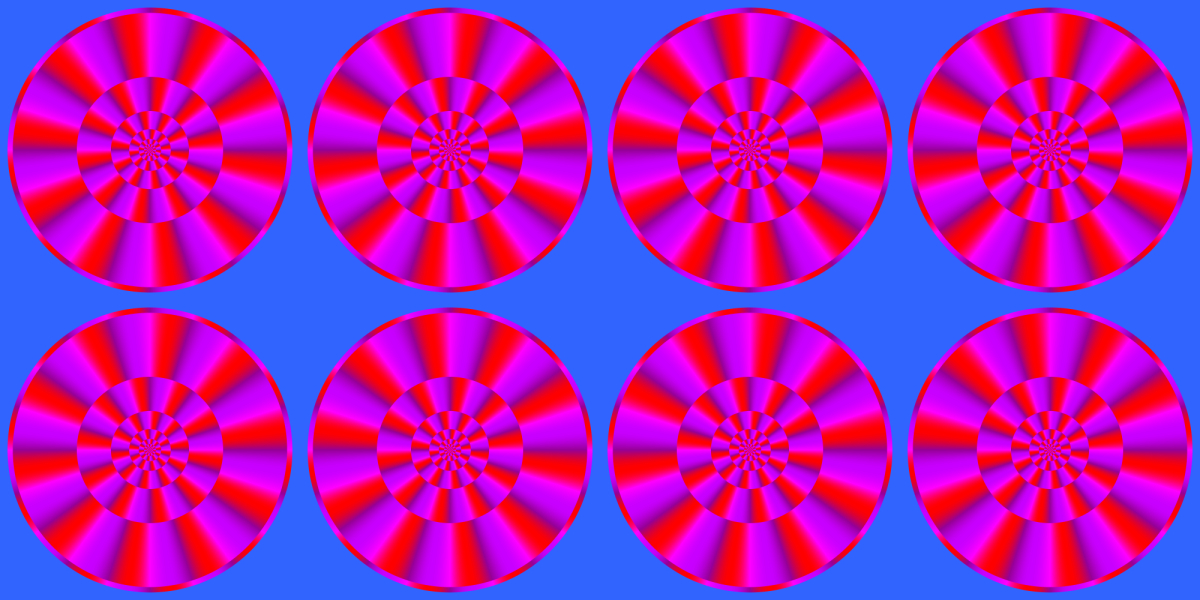
"Rotating red disks"
Disks appear to rotate.
Copyright Akiyoshi Kitaoka 2008 (December 18)
cf. Wezit
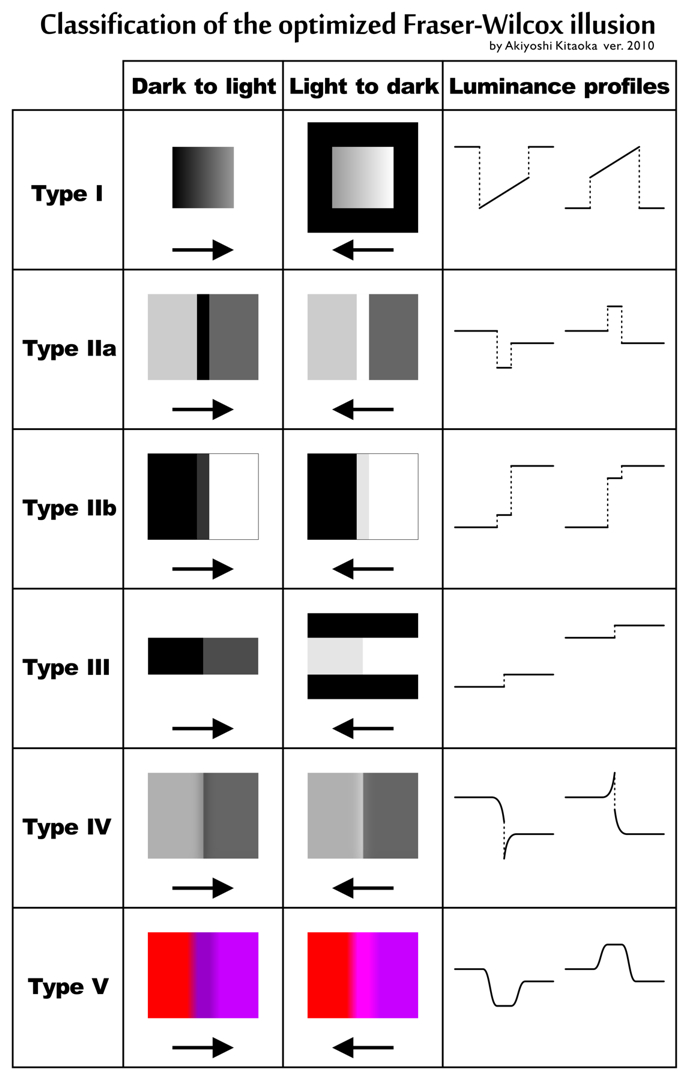
Kitaoka, A. (2007) Phenomenal classification
of the “optimized” Fraser-Wilcox illusion and the effect of color. Poster
presentation in DemoNight, VSS2007, GWiz, Sarasota, Florida, USA, May 14,
2007.
Kitaoka, A. (2008) Optimized Fraser-Wilcox illusions: A pictorial classification by Akiyoshi Kitaoka. Talk in a workshop (WS005) in the 72nd Annual Convention of the Japanese Psychological Association, Hokkaido University, Sapporo, September 19, 2008. Presentation page
For details:
北岡明佳著 人はなぜ錯視にだまされるのか? トリック・アイズ メカニズム カンゼン刊
(定価:1,600円(税別) ISBN 978-4-86255-020-0) amazon.co.jp
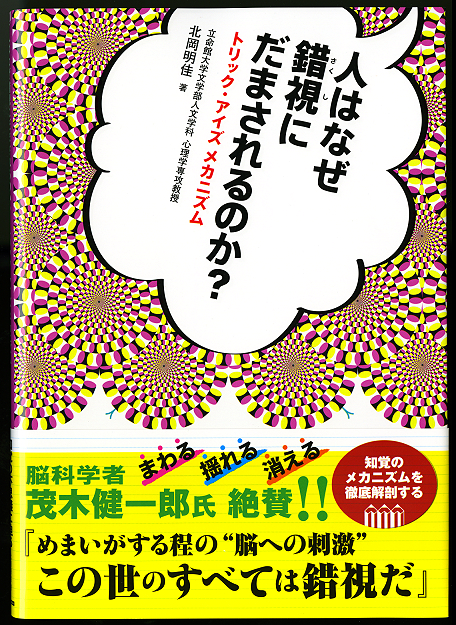
朝倉書店より、「錯視入門」出版!
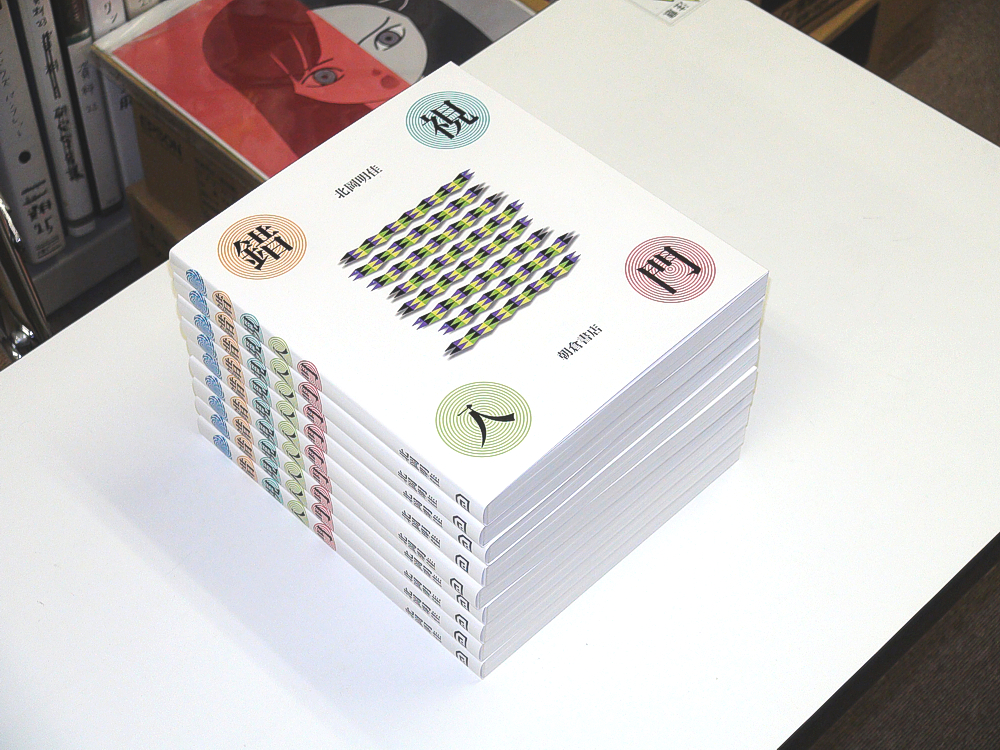
詳しくはこちら
1. Fraser and Wilcox (1979)
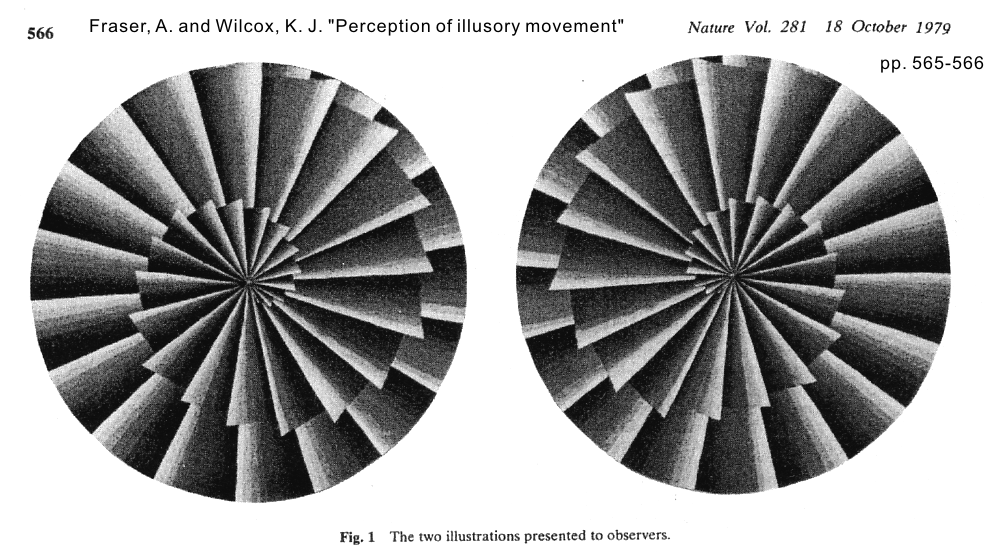
Fraser, A. and Wilcox, K. J. (1979) Perception of illusory movement. Nature, 281, 565-566.
2. Faubert and Herbert (1999)
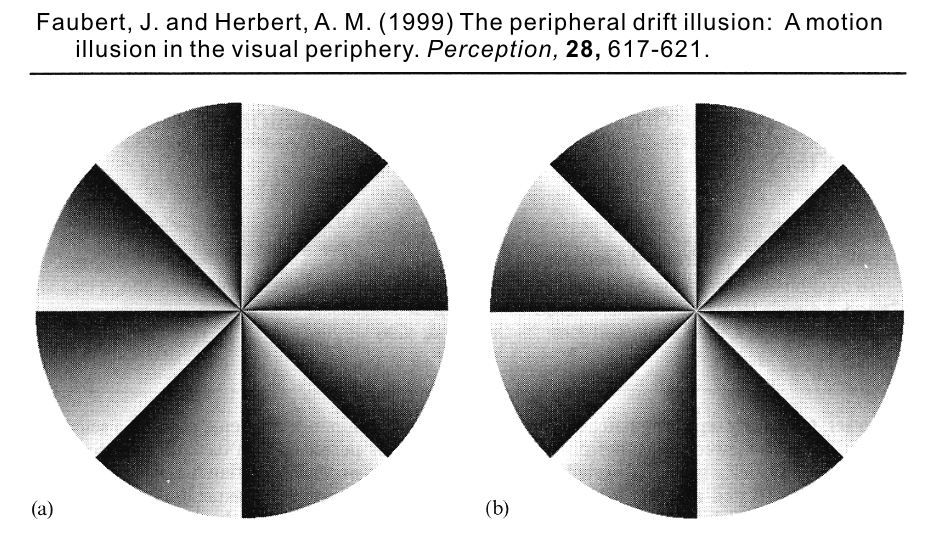
Faubert, J. and Herbert, A. M. (1999) The peripheral drift illusion: A motion illusion in the visual periphery. Perception, 28, 617-621.
3. Naor-Raz and Sekuler (2000)
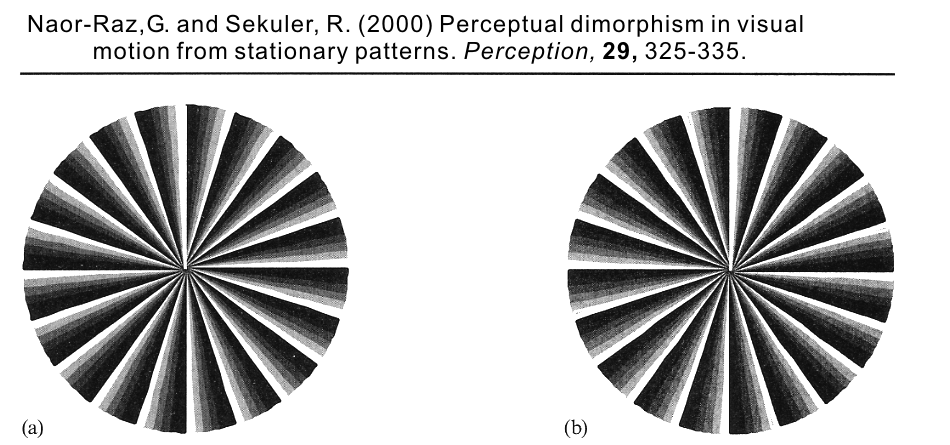
Naor-Raz, G. and Sekuler, R. (2000) Perceptual dimorphism in visual motion from stationary patterns. Perception, 29, 325-335.
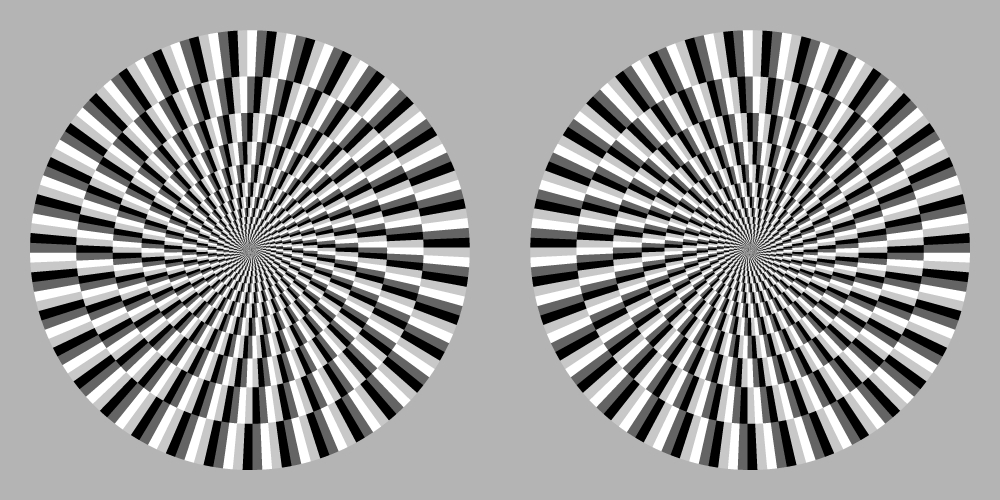
Kitaoka, A. and Ashida, H. (2003) Phenomenal characteristics of the peripheral drift illusion. VISION (Journal of the Vision Society of Japan), 15, 261-262
![]() Related references
Related references ![]()
Tomimatsu, E., Ito, H., Seno, T., and Sunaga, S. (2010) The ‘rotating snakes’ in smooth motion do not appear to rotate. Perception, 39, 721-724.
Fermüller, C., Ji, H., and Kitaoka, A. (2010) Illusory motion due
to causal time filtering. Vision Research, 50,
315–329. ![]()
Kuriki, I., Ashida, H., Murakami, I., and Kitaoka,
A. (2008) Functional brain imaging of the Rotating Snakes illusion by fMRI.
Journal of Vision, 8(10):16, 1-10. ![]()
Hisakata, R. and Murakami, I. (2008) The effects of eccentricity and retinal illuminance on the illusory motion seen in a stationary luminance gradient. Vision Research, 49, 1940-1948.
Beer, A. L., Heckel, A. H. and Greenlee, M. W. (2008) A motion illusion reveals mechanisms of perceptual stabilization. PLoS ONE, 3(7): e2741, 1-7. doi:10.1371/journal.pone.0002741 Freely available online
Chi, M-T., Lee, T-Y., Qu, Y., and Wong, T-T. (2008) Self-Animating Images: Illusory Motion Using Repeated Asymmetric Patterns. ACM Transaction on Graphics (Proceedings of SIGGRAPH 2008), 27, No.3. SIGGRAPH2008 --- Authors' page --- ![]()
Scientific American Reports Special Edition on Perception (2008). ![]()
Kitaoka, A. and Ashida, H. (2007) A variant of the anomalous motion illusion
based upon contrast and visual latency. Perception, 36, 1019-1035. ![]() PDF request to Akiyoshi Kitaoka
PDF request to Akiyoshi Kitaoka ![]()
Newton Press (Ed.), A. Kitaoka (Supervisor)
(2007) Newton magazine book: Special
issue "How is the brain deceived? Perfect demonstration of visual
illusions" Tokyo: Newton Press (in Japanese; published in October 2007). ![]()
Ramachandran, V. S. and Rogers-Ramachandran, D. (2007) A Moving Experience: How the eyes can see movement where it does not exist. Scientific American Mind, February/March, 14-16.
Kitaoka, A. (2007) Phenomenal classification of the “optimized” Fraser-Wilcox
illusion and the effect of color. Poster presentation in DemoNight, VSS2007,
GWiz, Sarasota, Florida, USA, May 14, 2007. 
Murakami, I., Kitaoka, A. and Ashida, H. (2006)
A positive correlation between fixation instability and the strength of illusory
motion in a static display. Vision Research, 46, 2421-2431. ![]() PDF request
should be sent to Dr. Murakami
PDF request
should be sent to Dr. Murakami ![]()
Kitaoka, A. (2006) Anomalous motion illusion and stereopsis. Journal of Three Dimensional Images (Japan), 20, 9-14. PDF (manuscript but the same as the printed one)
Kanazawa, S., Kitaoka, A. and Yamaguchi, M. K. (2006) Infants see the “Rotating Snake” illusion. Dorsal and ventral streams in the visual system (Talk): Monday, 21 August 2006; 12:00-12:30 (29th European Conference on Visual Perception, St-Petersburg, Russia, 20th-25th August, 2006) Abstract
Kitaoka, A., Ashida, H., and Murakami, I. (2005) Does the peripheral drift illusion generate illusory motion in depth? Journal of Three Dimensional Images (Tokyo), 19, 6-8. PDF (scanned copy) (poor quality) --- MS-Word file (manuscript, the same as the paper) (high quality)
Conway, R. B., Kitaoka, A., Yazdanbakhsh, A., Pack, C. C., and Livingstone,
M. S. (2005) Neural basis for a powerful static motion illusion. Journal of Neuroscience, 25, 5651-5656. ![]() PDF request should be sent to Dr. Conway
PDF request should be sent to Dr. Conway ![]()
Backus, B. T. and Oruç, I. (2005) Illusory motion from change over time in the response to contrast and luminance. Journal of Vision, 5, 1055-1069. http://journalofvision.org/5/11/10/
Kitaoka, A. and Ashida, H. (2003) Phenomenal characteristics of the peripheral drift illusion. VISION, 15, 261-262.PDF
Findings of the "Rotating snakes" illusion (optimized Fraser-Wilcox illusion)
1. Illusion is strong in the peripheral vision
Kitaoka, A. and Ashida, H. (2003) Phenomenal characteristics of the peripheral drift illusion. VISION, 15, 261-262.PDF
2. Illusion is strong when the image is of high luminance
Hisakata, R. and Murakami, I. (2008) The effects of eccentricity and retinal illuminance on the illusory motion seen in a stationary luminance gradient. Vision Research, 49, 1940-1948.
3. Illusion requires some eye movement
Murakami, I., Kitaoka, A. and Ashida, H. (2006) A positive correlation between fixation instability and the strength of illusory motion in a static display. Vision Research, 46, 2421-2431.
Kuriki, I., Ashida, H., Murakami, I., and Kitaoka, A. (2008) Functional brain imaging of the Rotating Snakes illusion by fMRI. Journal of Vision, 8(10):16, 1-10.
4. Illusion does not occur in the stabilized retinal image
Murakami, I., Kitaoka, A. and Ashida, H. (2006) A positive correlation between fixation instability and the strength of illusory motion in a static display. Vision Research, 46, 2421-2431.
5. Illusion is enhanced by color
Kitaoka, A. (2007) Phenomenal classification of the “optimized” Fraser-Wilcox illusion and the effect of color. Poster presentation in DemoNight, VSS2007, GWiz, Sarasota, Florida, USA, May 14, 2007.
6. Illusion is weak when the image is moved
Tomimatsu, E., Ito, H., Seno, T., and Sunaga, S. (2010) The ‘rotating snakes’ in smooth motion do not appear to rotate. Perception, 39, 721-724.
7. Illusion is weak when the image is observed through pinholes
Cantor, C. R. L., Tahir, H. J., and Shor, C. M. (2010) Is the rotating snakes an optical illusion? VSS2010, #26.434.
Major models of the "Rotating snakes" illusion (optimized Fraser-Wilcox illusion)
1. Adaptation (temporal positional shift)
Backus, B. T. and Oruç, I. (2005) Illusory motion from change over time in the response to contrast and luminance. Journal of Vision, 5, 1055-1069.
2. Visual delay (temporal positional shift) related issue 1 _ related issue 2
Conway, R. B., Kitaoka, A., Yazdanbakhsh, A., Pack, C. C., and Livingstone, M. S. (2005) Neural basis for a powerful static motion illusion. Journal of Neuroscience, 25, 5651-5656.
3. Motion signal asymmetry
Murakami, I., Kitaoka, A. and Ashida, H. (2006) A positive correlation between fixation instability and the strength of illusory motion in a static display. Vision Research, 46, 2421-2431.
4. Imaginary motion detector model (My speculation)
1. Imaginary motion detectors for the optimized Fraser-Wilcox illusion Type IIa
(the same configuration as the line components in the Fraser illusion family)
2. It is assumed that the image given to imaginary motion detectors gradually becomes clear after presentation or refreshment.
3. This temporal change activates the imaginary motion detector in the same manner as the (classic) reversed phi (Anstis, 1970) or phenomenal phenomena (Gregory and Heard, 1983).
Flash(swf) --- QuickTime(mov)
Kitaoka, A. (2006) Configurational coincidence among six phenomena: A comment on van Lier and Csathó (2006). Perception, 35, 799-806. animations
The "central drift illusion" is featured by illusory motion in the direction low-to-high contrast.
Kitaoka, A. and Ashida, H. (2004) A new
anomalous motion illusion: the "central drift illusion". The 2004's winter meeting of the Vision Society
of Japan at the Kogakuin University, Shinjuku, Tokyo, Japan, 2004/1/26-28,
1/26 oral publication. Presentation (html)
This illusion does not depend on the luminance gradient of inducers. Although the luminance gradients are the same (white to gray) between the two figures shown below, the direction of illusory motion is opposite to each other. The upper two rows in the left figure appear to move leftward while those in the right figure appear to slide rightward; the lower two rows in the left figure appear to move rightward while those in the right figure appear to slide leftward.

The only difference in stimuli is whether the background is gray or white. It is therefore suggested that the critical factor to generate this illusion be contrast. In this case, the direction of illusory motion can be described as "low-to-high contrast".
3. 渦巻き錯視

「YPSうずしお」
同心円配列したパターンが渦巻きに見える。目を動かすたびに円盤が急速に回転して見える。
Copyright Akiyoshi Kitaoka 2010 (August 7)
リフレッシュ依存の回転錯視
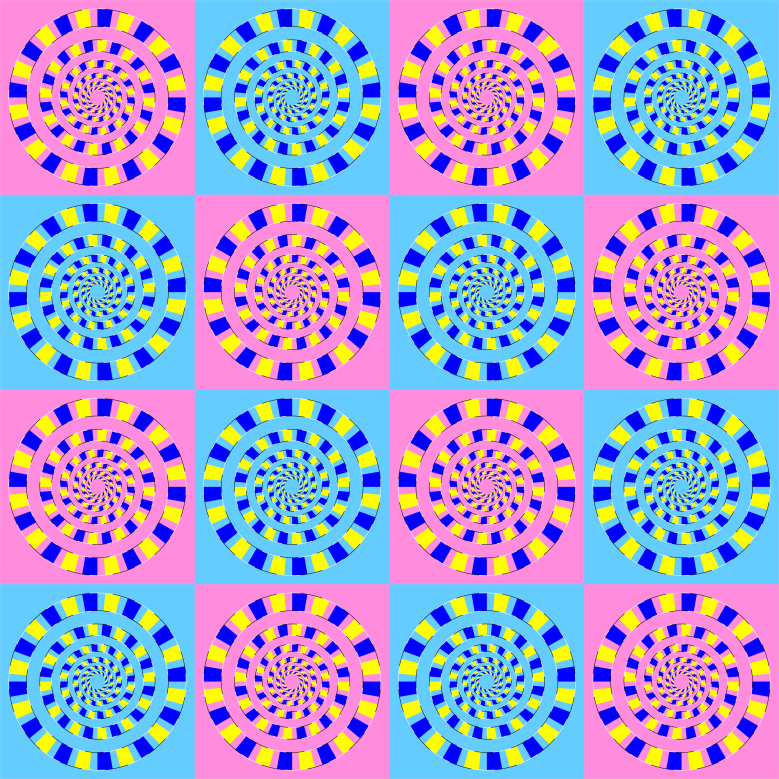
「渦巻きの詰め合わせ」
同心円のリングが渦巻きに見える。ついでに回転して見える。
Copyright Akiyoshi .Kitaoka 2006 (June 13)
Kitaoka, A., Pinna, B., and Brelstaff, G. (2001). New variations of spiral illusions. Perception, 30, 637-646. ![]()
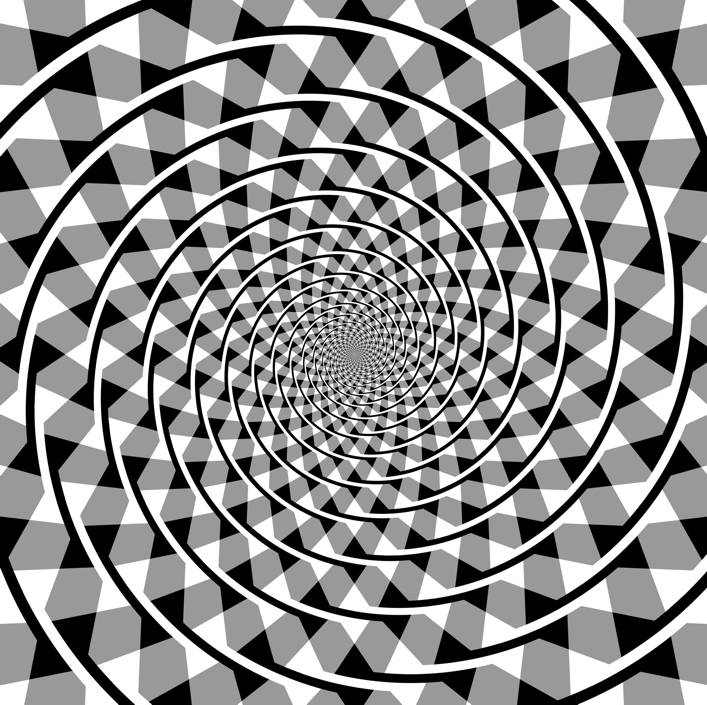
フレーザー錯視の渦巻き錯視
同心円が渦巻きに見える。
フレーザー錯視基本図形・・・水平に並べた斜線の列全体が傾いて見える。上から、反時計回り、時計回り、反時計回り、時計回り。
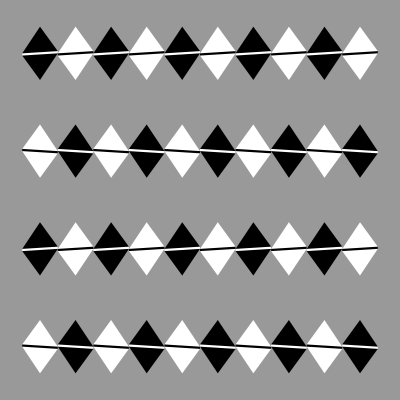
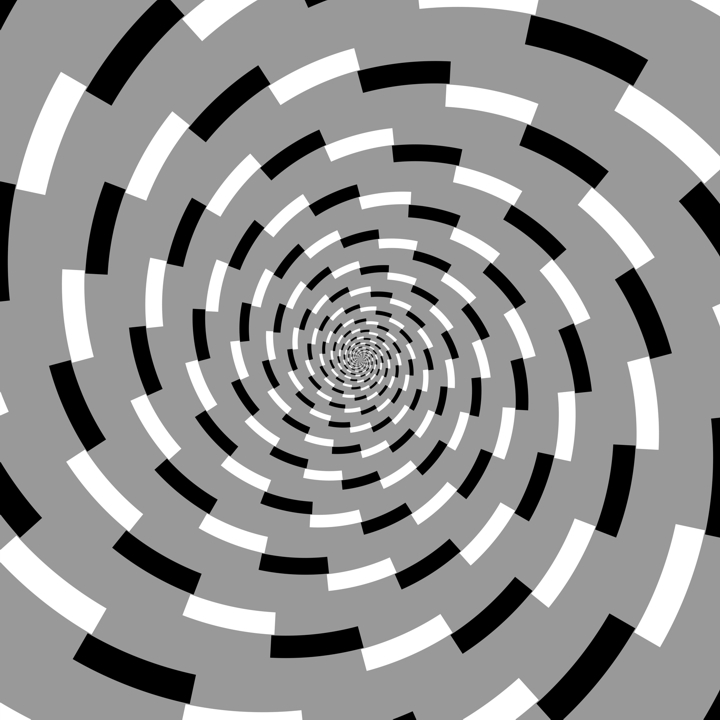
単純化したフレーザー錯視の渦巻き錯視
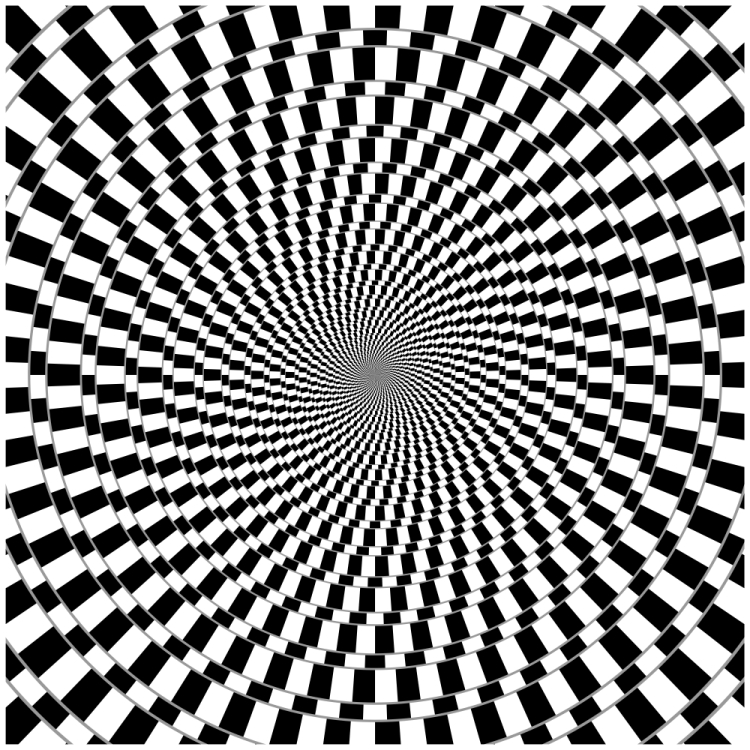
カフェウォール錯視の渦巻き錯視
カフェウォール錯視
アンモナイトの化石(本物らしい・北岡蔵・2000円もした)
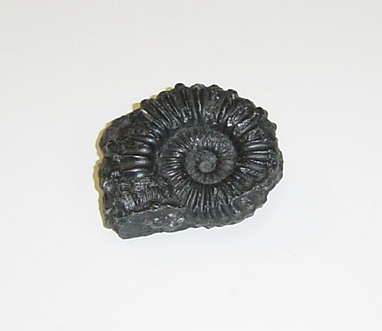
ちょっと地学・古生物学のお勉強
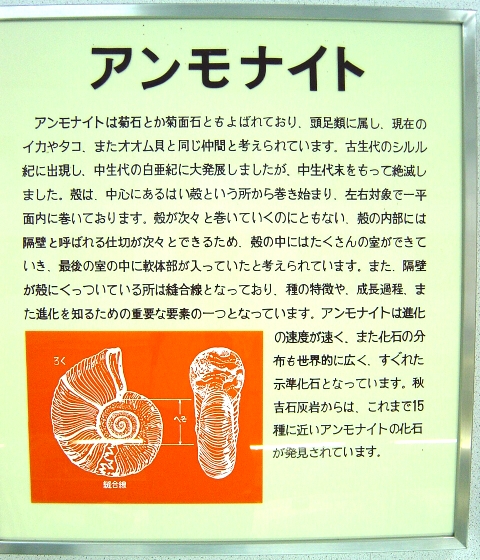
オウムガイの例 (水生生物雑記帳)
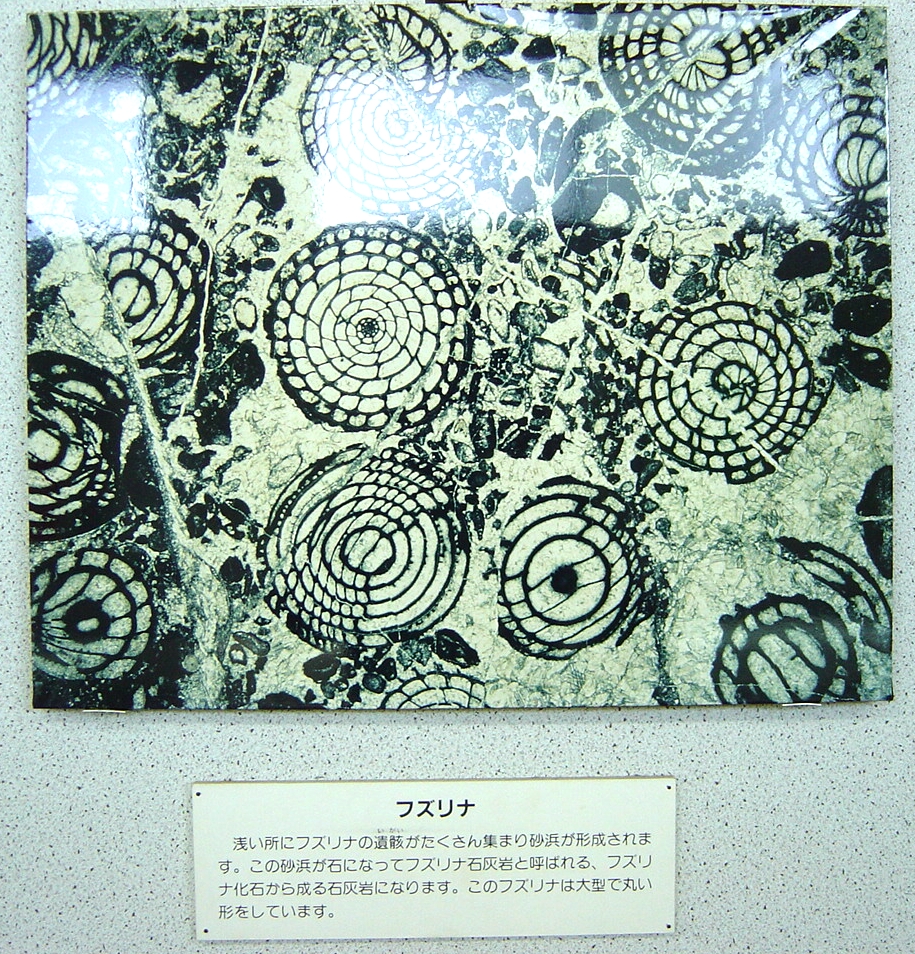
アルキメデスの螺旋
r = a・θ
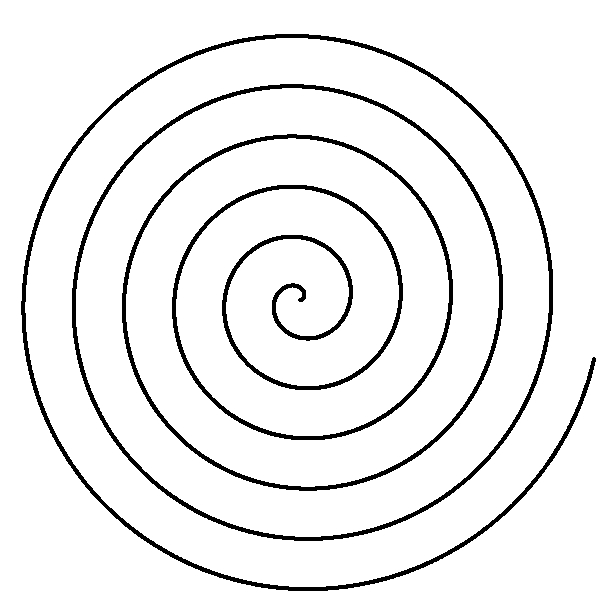
描画プログラム(Spiral1a.exe) (ウインドウズ専用)
ベルヌーイの螺旋(対数螺旋あるいは等角螺旋ともいう)
r = a・exp (k・θ)
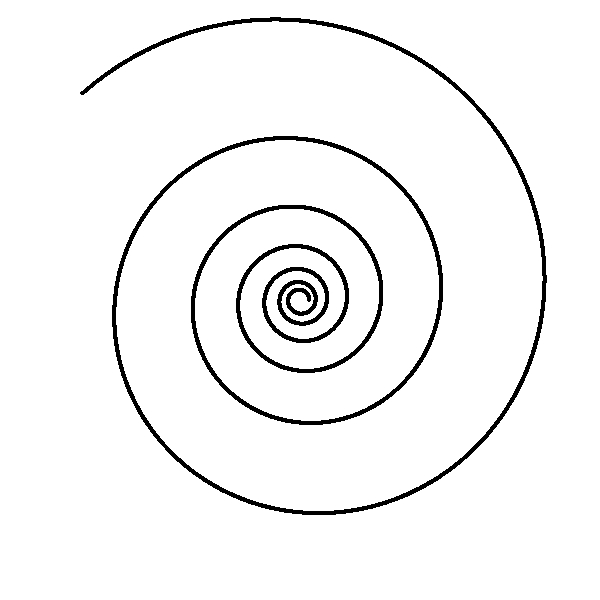
描画プログラム(Spiral1.exe) (ウインドウズ専用)
ベルヌーイの螺旋(等角螺旋)では、螺旋上のある点と中心を結ぶ線分と、その点における接線の成す角度は、すべての点において一定である。
k = 1 / tan (φ)
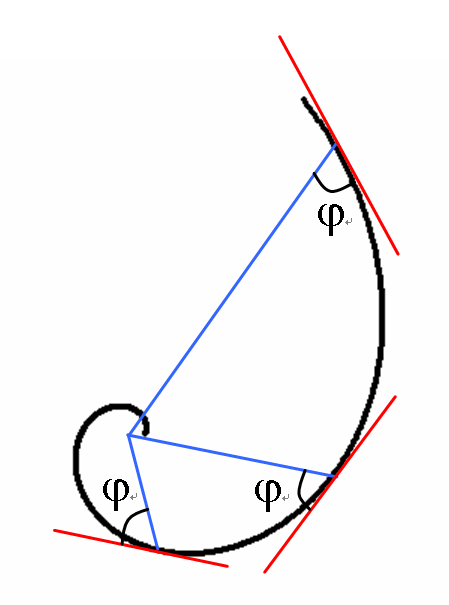
線パターンによる放射状パターン (φ = 0º)
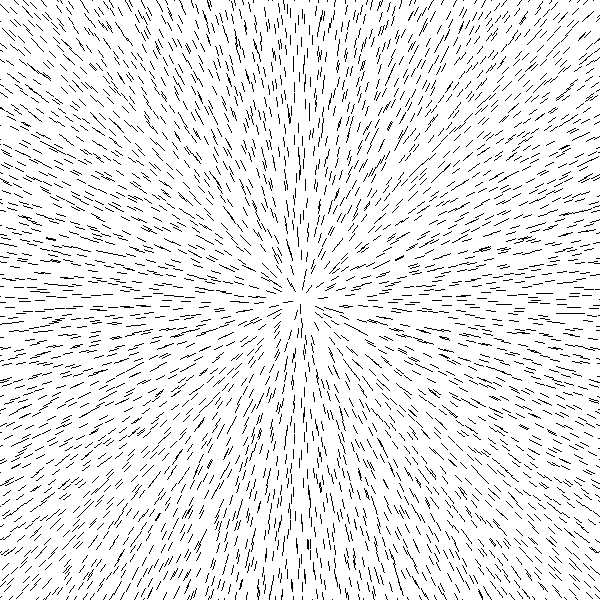
(radial pattern)
描画プログラム(SpiralGP3b.exe)(ウインドウズ専用)
線パターンによる渦巻きパターン (φ = 65º)
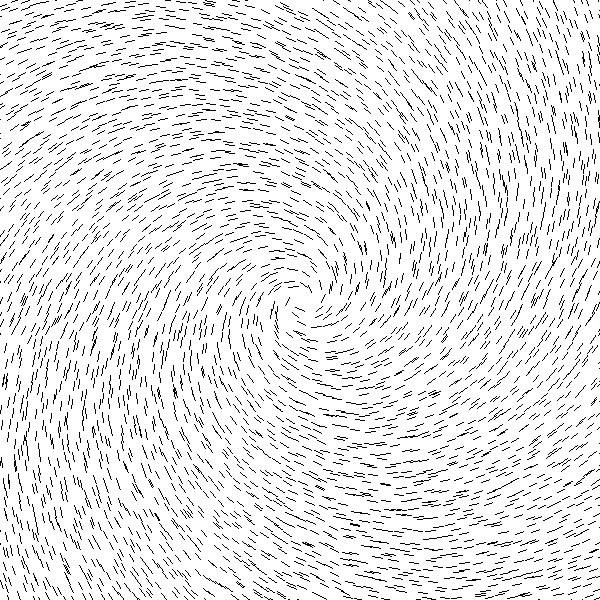
(spiral pattern)
線パターンによる同心円パターン (φ = 90º)
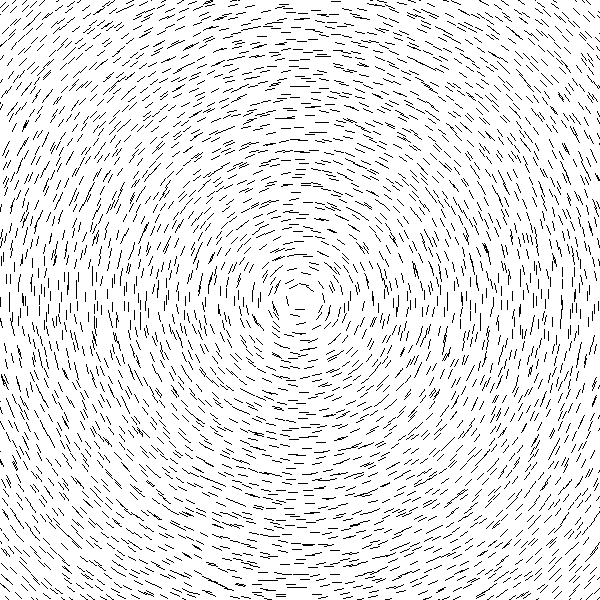
(concentric pattern)
渦巻き錯視は、局所的な傾き錯視による渦巻き検出器の誤動作で起こると考えられる。
Kitaoka, A., Pinna, B., and Brelstaff, G. (2001). New variations of spiral illusions. Perception, 30, 637-646.
4. 同居性の傾き錯視&動く錯視
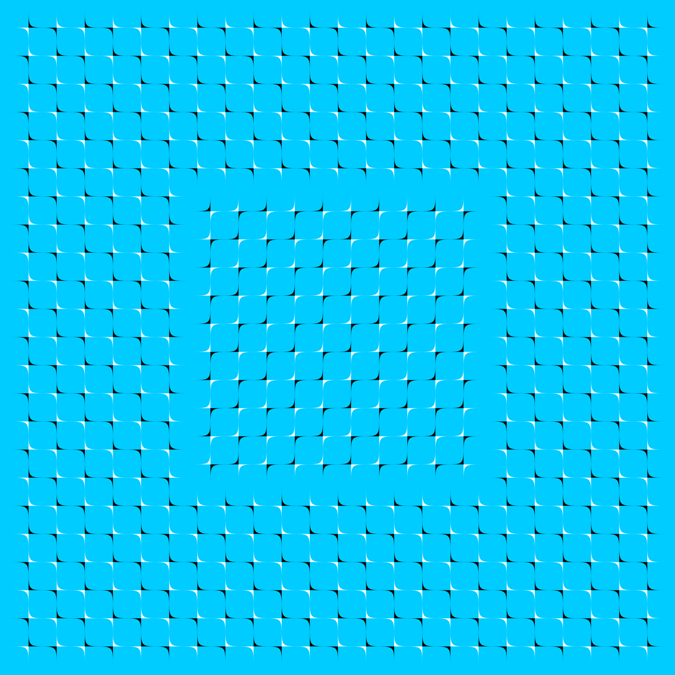
「YPSトゲトゲドリフト錯視」
内側の領域が網膜像の動きに依存して動いて見える。また、各要素は垂直・水平に配列しているが傾いて見える。
Copyright Akiyoshi Kitaoka 2010 (August 7)
Tilt illusion is a subcategory of geometrical illusion, in which lines or edges appear to tilt clockwise or counterclockwise. (e.g., Zöllner illusion, Fraser illusion, Café Wall illusion)
Anomalous motion illusion refers to motion illusion in a stationary image, in which part of the
stationary image appears to move. (e.g., Ouchi illusion, Enigma illusion,
optimized Fraser-Wilcox illusion)
Some* types of tilt illusions are accompanied by anomalous motion illusion. (e.g., Illusion of Y-junctions)
*Later, I have realized that most of tilt illusions (including the Fraser illusion and the Café Wall illusion) share the same image with anomalous motion illusion.
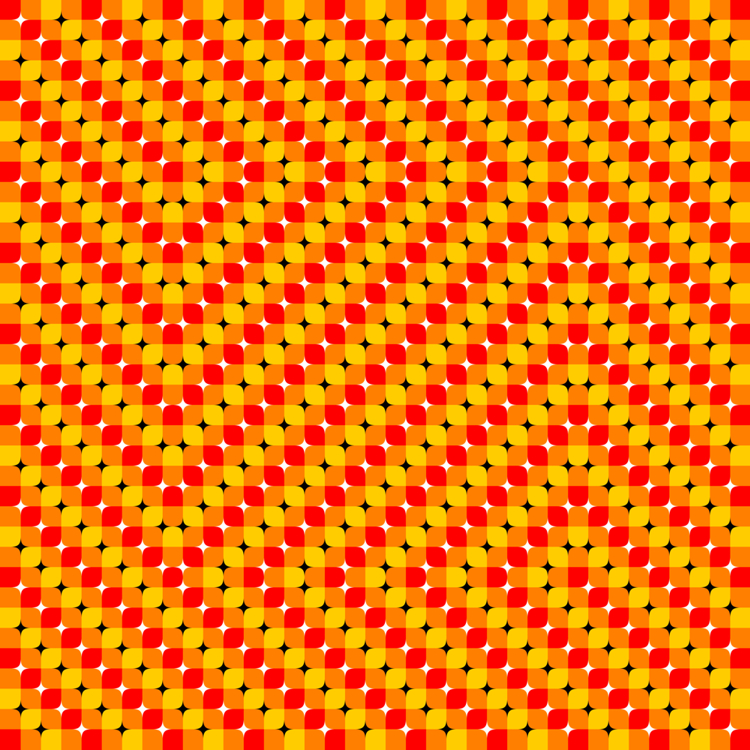
"The autumn color swamp"
The inset appears to move.
Copyright A.Kitaoka 2000, 2003, 2007, 2010
<Handout>
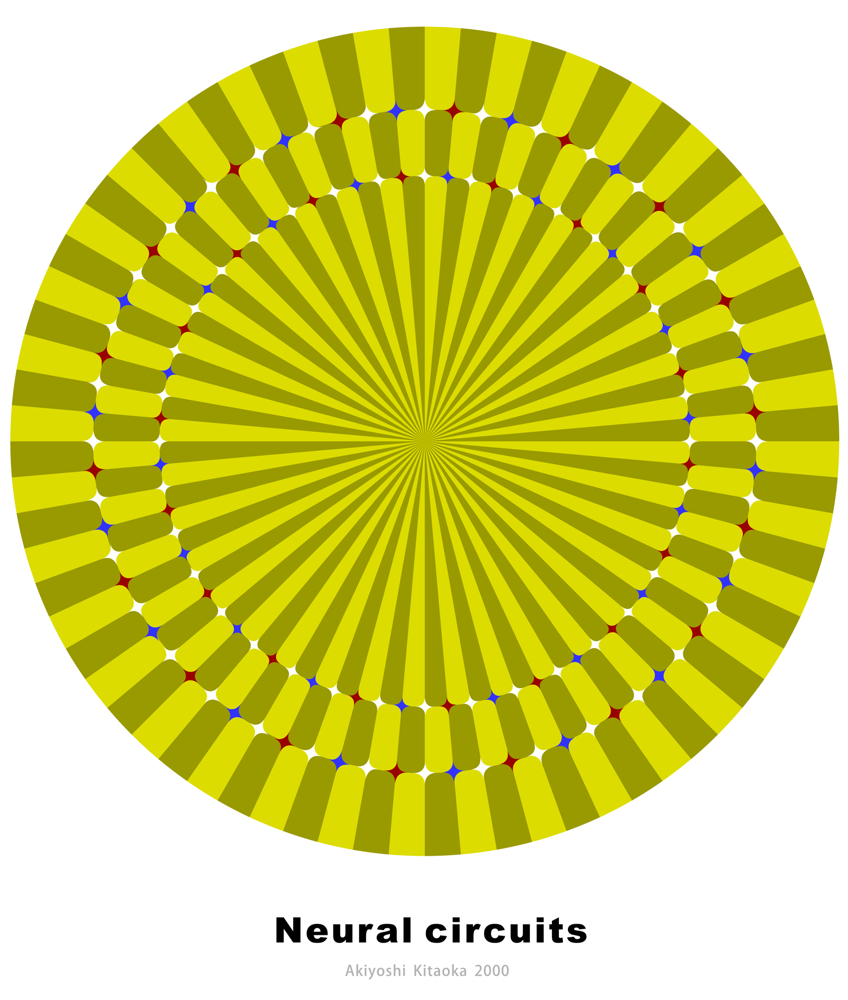
The two concentric arrays of stars appear to rotate in the different directions when we approach or move away from the figure while fixating at the center.
Copyright Akiyoshi Kitaoka 2000, 2010
<Handout>
Illusion of Y-junctions

The elemental image as the tilt illusion
The horizontal edge on which black or white stars are placed appears to tilt counterclockwise.
Kitaoka, A., Pinna, B., and Brelstaff, G. (2001). New variations of spiral
illusions. Perception, 30, 637-646.
Kitaoka, A., Pinna, B., and Brelstaff, G. (2004). Contrast polarities determine the direction of Cafe Wall tilts. Perception, 33, 11-20.
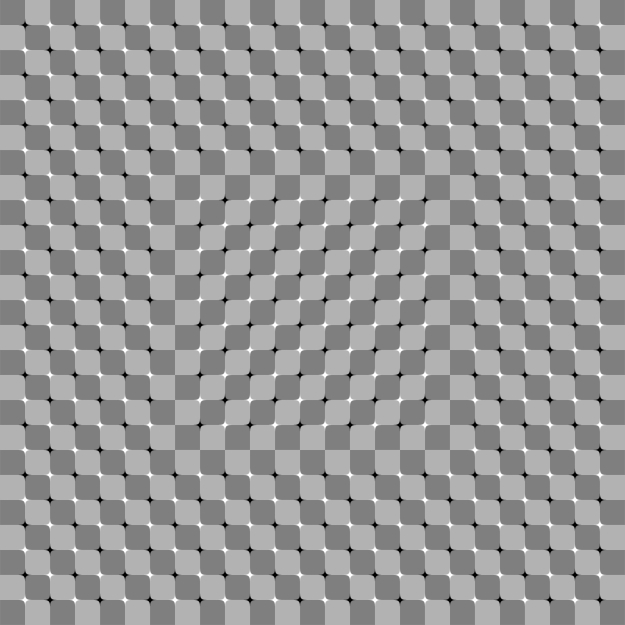
The elemental image as anomalous motion illusion
The inset appears to move. When the retinal image is moved vertically, the inset appears to move horizontally. When the retinal image is moved horizontally, the inset appears to move vertically.
<Handout>
Conclusion: The Fraser illusion family consists of six (3 x 2) illusions.
<Handout>
Q. How is the pseudo-Fraser illusion related to the Café Wall illusion?
A. I think they are essentally the same illusion.
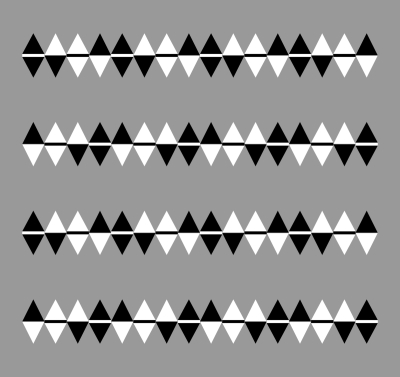
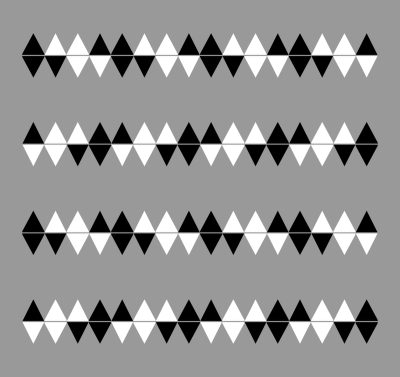
The pseudo-Fraser illusion (left) and the Café Wall illusion (right)
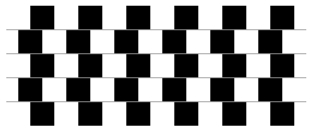
Café Wall illusion: a standard image
cf. Gregory, R. L. and Heard, P. (1979) Border locking and the Café Wall illusion. Perception, 8, 365-380.
Q. Does tilt illusion occur where contast polarity changes?
A. Yes, as if it were the reversed phi (the direction opposite to the shift).
(Illusion of oblique edges)
(Illusion of shifted lines)
Example
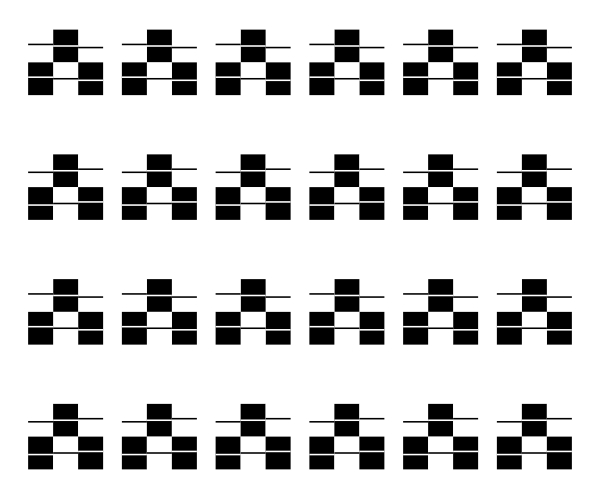
"Derby man tilt illusion"
Horizontally aligned rows of "derby men" appear to tilt alternately. From the top, counterclockwise, clockwise, and so on.
Copyright Akiyoshi Kitaoka 2010 (March 21)
My idea: There are eight fundamental combinations of basic components.
(I imagine that neurons with receptive fields like these play a part)
(The limiting case of the Fraser illusion family)
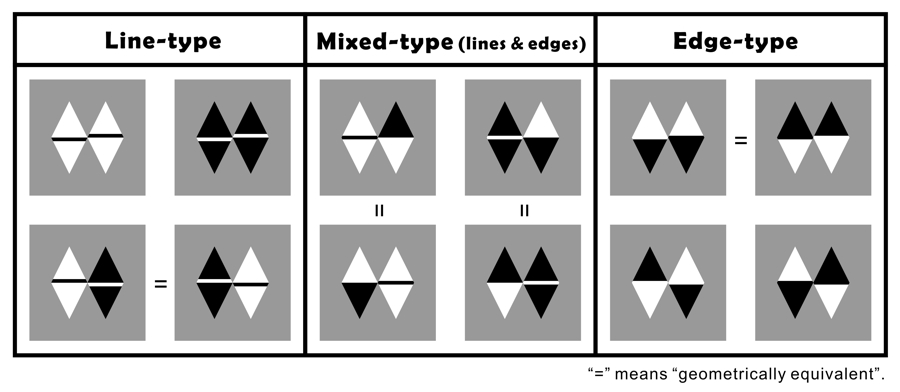
In each gray square, the middle line or edge appears to tilt counterclockwise.
Copyright Akiyoshi Kitaoka 2010 (March 22)
In addition: Café Wall illusion can be explained with this idea.

Café Wall illusion: a standard image
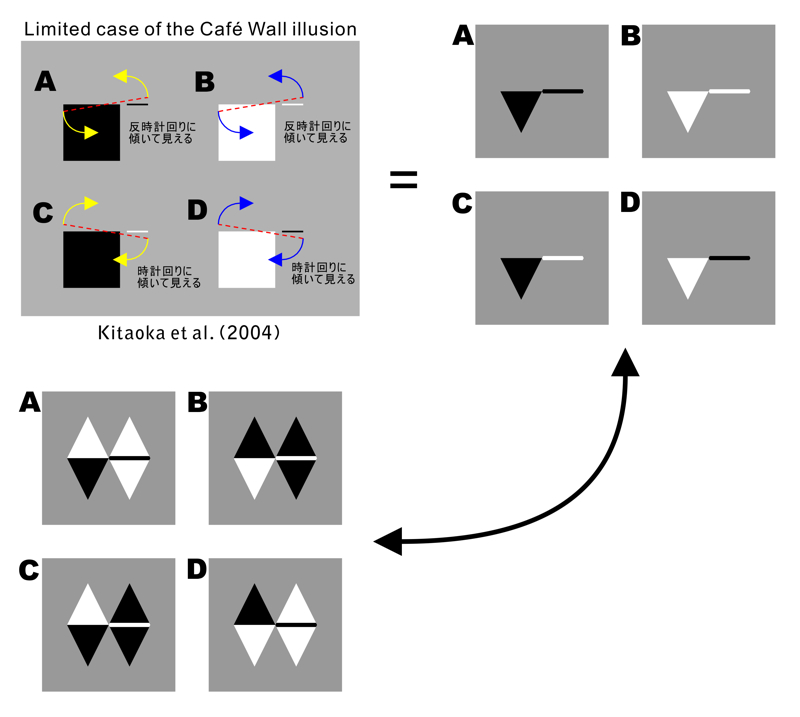
Copyright Akiyoshi Kitaoka 2010 (March 22)
Kitaoka, A., Pinna, B., and Brelstaff, G. (2004) Contrast polarities determine the direction of Café Wall tilts. Perception, 33, 11-20.
§2. Anomalous motion illusion accompanied by tilt illusion

"Obake-hime"
obake = ghost; hime = princess or girl
The face appears to expand; the group of bats appears to rotate counterclockwise. This is Professor Mather's four-stroke motion.
Copyright Akiyoshi Kitaoka 2009 (August 10)
Professor Mather's demonstration is the best.
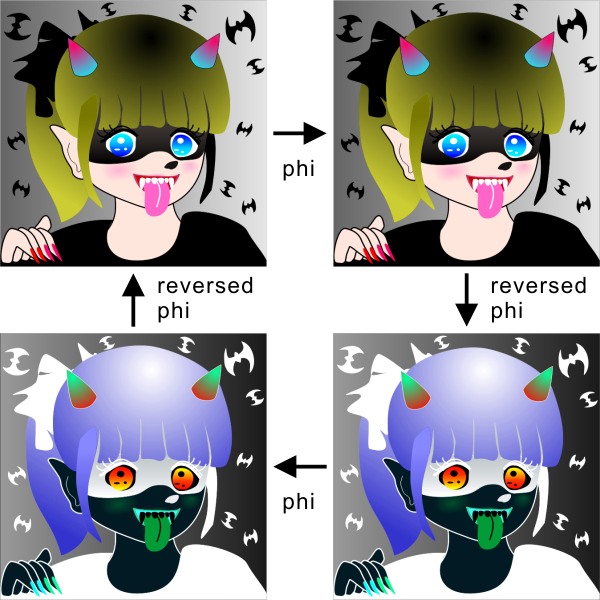
Copyright Akiyoshi Kitaoka 2010 (March 22)
(Reversed phi only)

Copyright Akiyoshi Kitaoka 2010 (March 22)
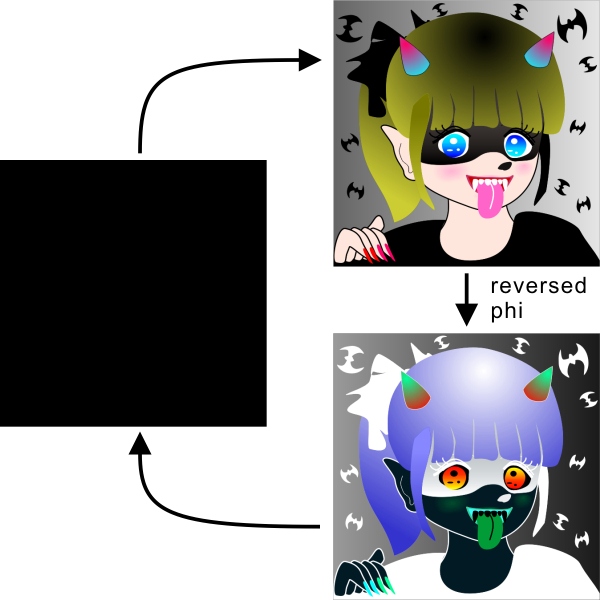
Reversed phi movement (Anstis and Rogers 1975). There are four rectangles, each of which is flanked by thin lines that are dark or light. When the luminance of the rectangles decreases and that of the background increases accordingly, the upper two appear to converge in motion while the lower two appear to go apart in motion. On the other hand, when the luminance of the rectangles increases and that of the background decreases accordingly, the upper two appear to go apart in motion while the lower two appear to approach each other in motion. In sum, the direction of apparent motion is from the dark flank to the neighboring part that goes darkening or from the light flank to the neighboring part that goes brightening. Although the rectangles are aligned vertically, the apparent positional displacement occurs in the opposite direction to motion. If observers cross-fuse (uncross-fuse) the right and left rectangles, the upper rectangle appears to be in front of (behind) the lower one when they are dark.
Kitaoka, A. (2006) Configurational coincidence
among six phenomena: A comment on van Lier and Csathó (2006). Perception,
35, 799-806. animations ![]()
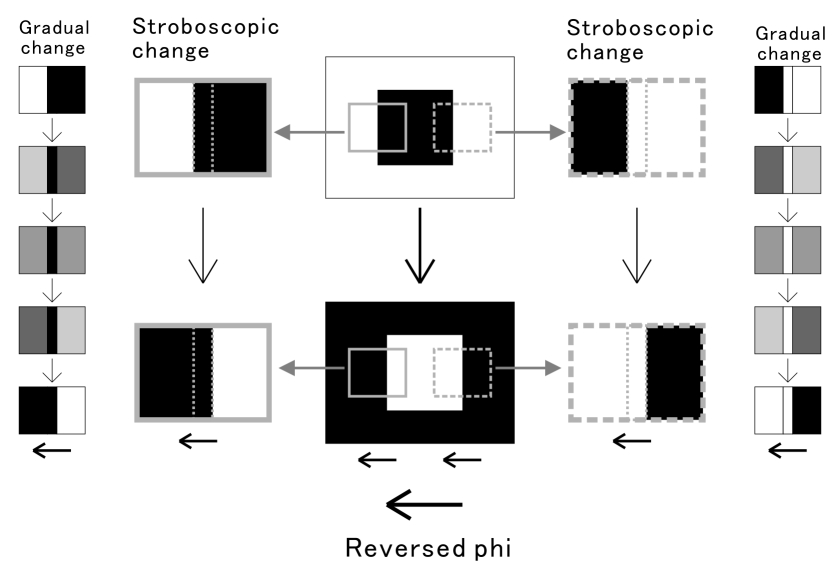
Anstis S M, 1970 “Phi movement as a subtraction process” Vision Research 10 1411-1430
Anstis S M, Rogers B J, 1975 “Illusory reversal of visual depth and movement during changes of contrast” Vision Research 15 957-961
4-stroke motion corresponding to the Line Type
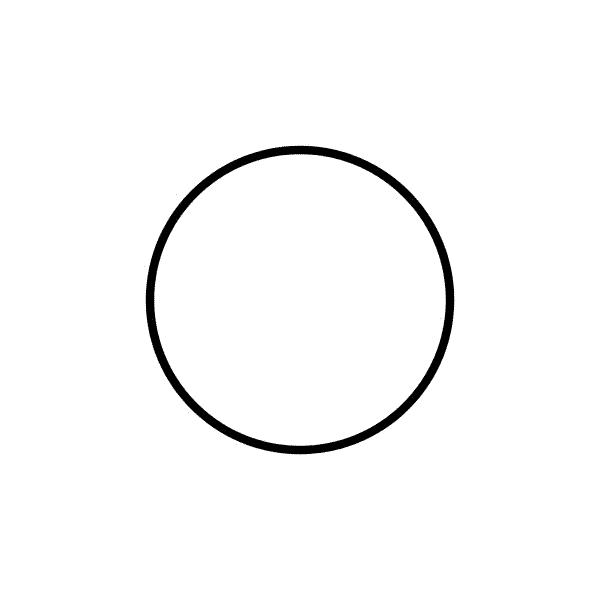
Copyright Akiyoshi Kitaoka 2010 (March 22)
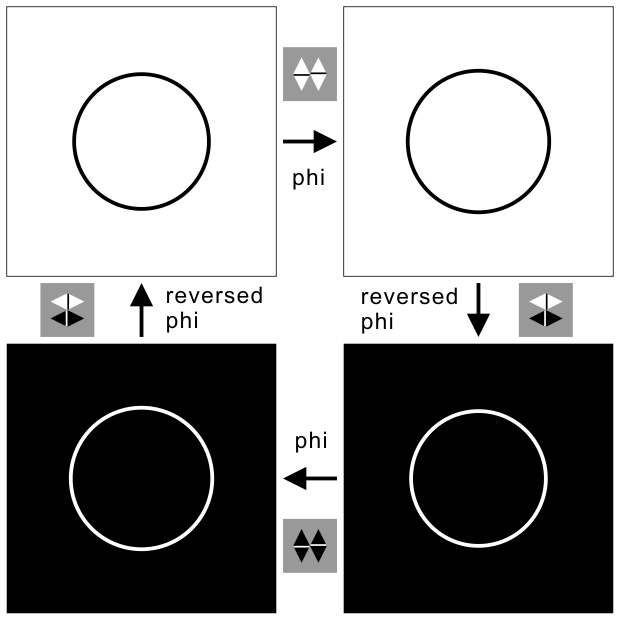
Finding: The direction of motion is the same as the tilt illusion.
cf. van Lier R, Csathó Á, 2005 “Dancing shapes: A comparison of luminance induced distortions” Perception, 35, 775 – 798.
4-stroke motion corresponding to the Edge Type
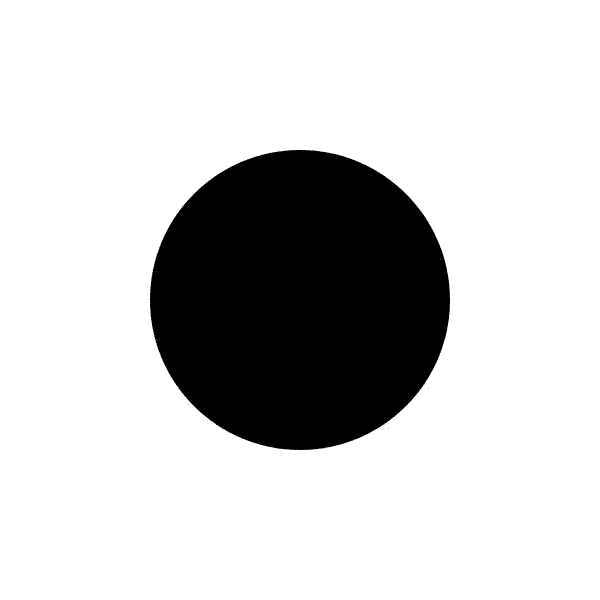
Copyright Akiyoshi Kitaoka 2010 (March 22)
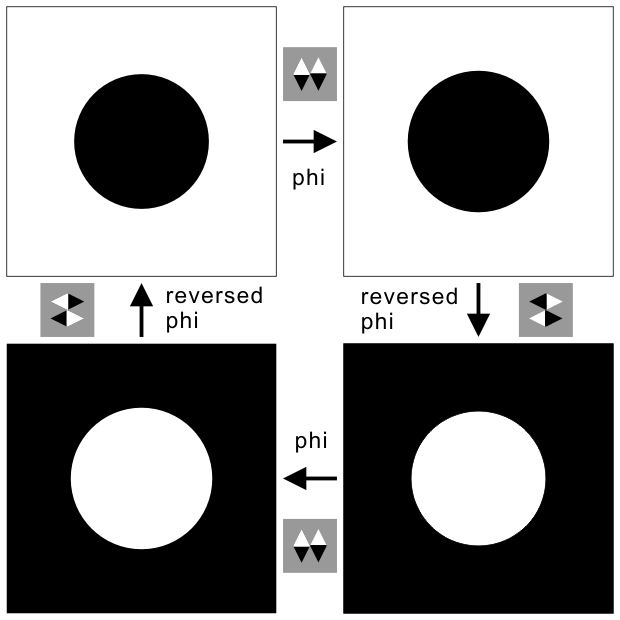
Finding: The direction of motion is the same as the tilt illusion.
cf. van Lier R, Csathó Á, 2005 “Dancing shapes: A comparison of luminance induced distortions” Perception, 35, 775 – 798.
4-stroke motion corresponding to the Mixed Type
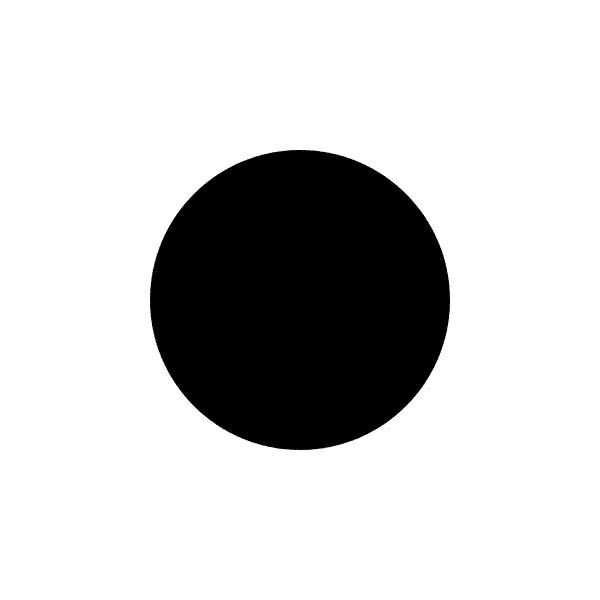
Copyright Akiyoshi Kitaoka 2010 (March 22)
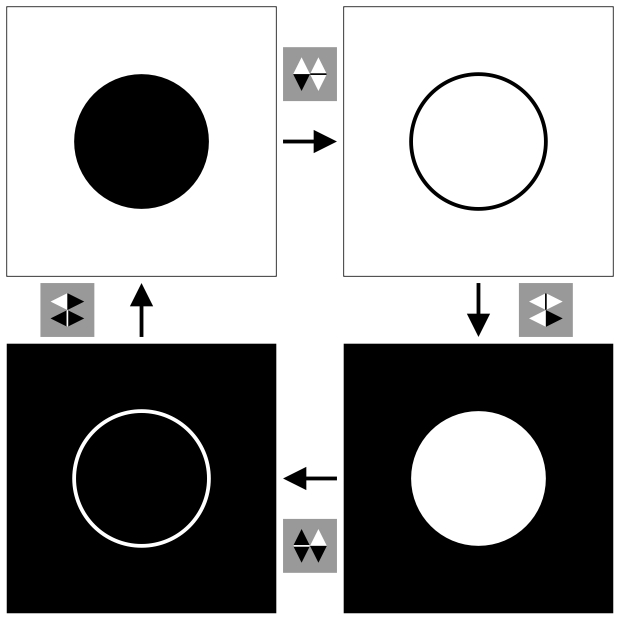
Finding: The direction of motion is the same as the tilt illusion.
<Takeuchi's four-stroke motion>
Takeuchi, T. (1997) The motion analogue of the cafe wall illusion. Perception, 26, 569-584.
Then, anomalous motion illusions that coexist in tilt illusion images can be explained in this context.
When the retinal image slides in the special direction, the orientation along which the tilt illusion occurs, the four-stroke motion is induced and anomalous motion illusion is observed.
Copyright Akiyoshi Kitaoka 2010 (June 26)
<Handout>
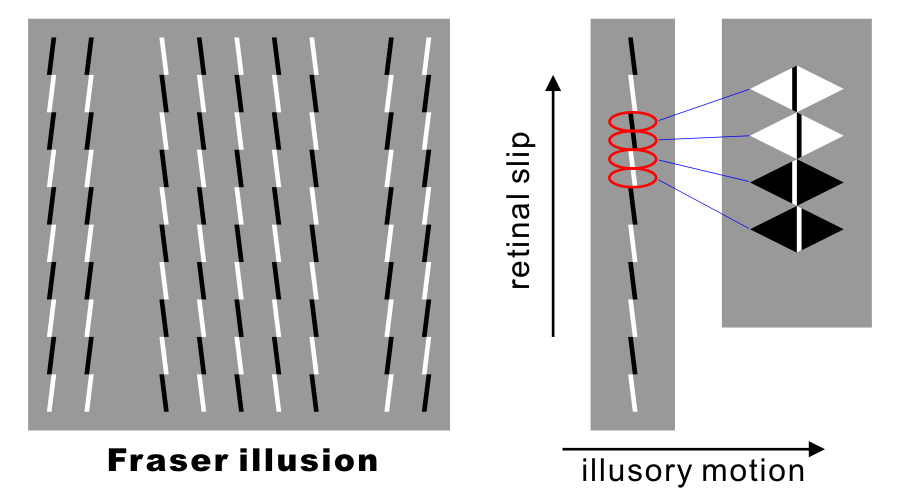
"Rain"
The inset appears to move.
Copyright Aliyoshi Kitaoka 2005 (July 2)
Explanation of the illusion of Y-junctions
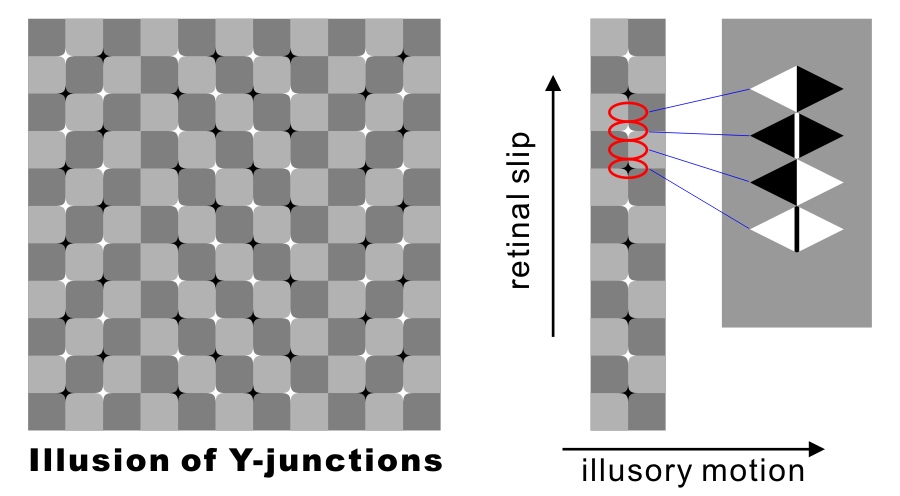
Drawn by Aliyoshi Kitaoka 2010 (June 25)

(Takeuchi's four-stroke motion)
<Two dimensional displays>

Illusion of Y-junctions
Kitaoka, A., Pinna, B., and Brelstaff, G. (2001). New variations of spiral
illusions. Perception, 30, 637-646.
Kitaoka, A., Pinna, B., and Brelstaff, G. (2004). Contrast polarities determine the direction of Cafe Wall tilts. Perception, 33, 11-20.
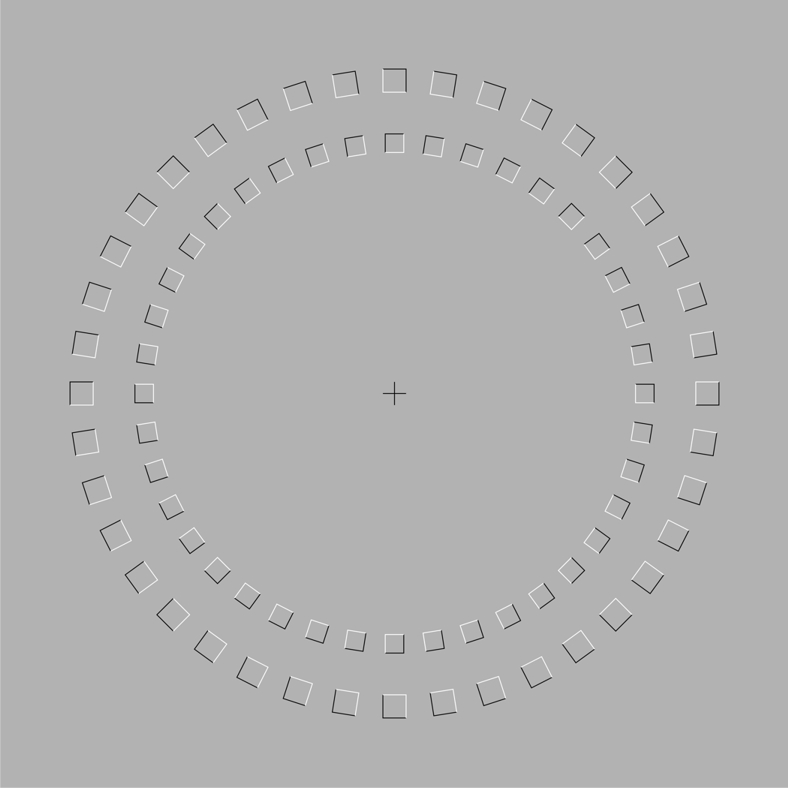
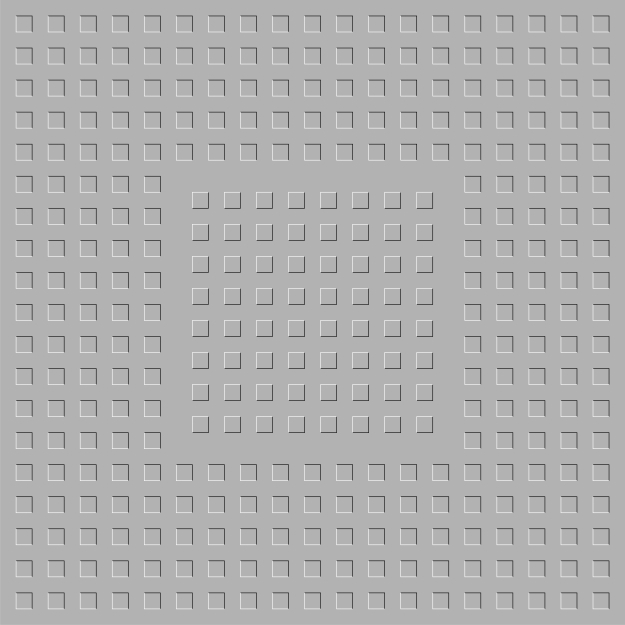
Pinna Illusion
Pinna, B. and Brelstaff, G. J. (2000) A new visual illusion of relative motion. Vision Research, 40, 2091-2096.
Explanation of the Pinna illusion
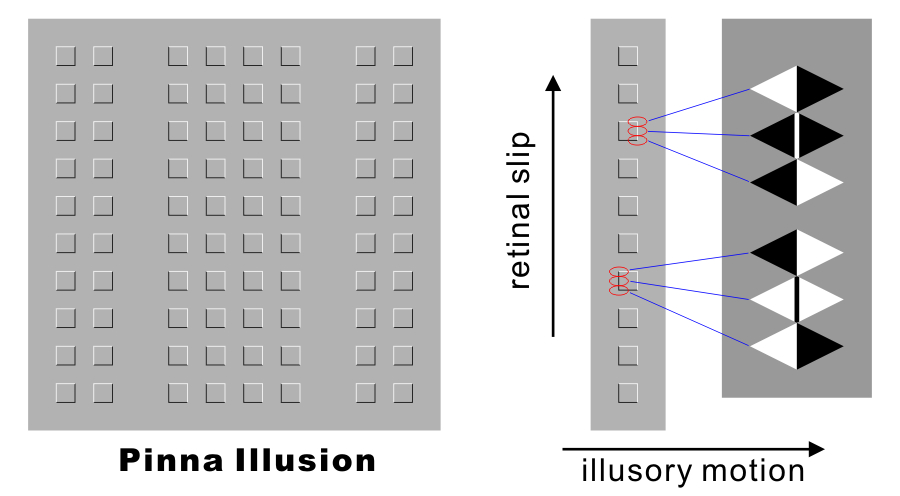
New: This idea led me to produce a novel illusion "spine drift illusion".
"Spine drift
illusion"
The inset appears to move.
Copyright Akiyoshi Kitaoka 2010 (June 4)
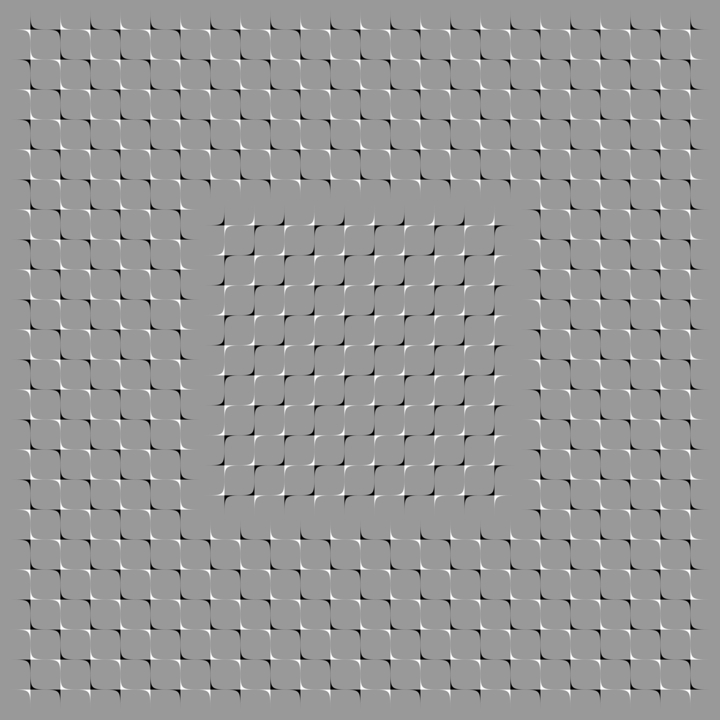
"Spine drift illusion"
The inset appears to move.
Copyright Akiyoshi Kitaoka 2010 (July 6)
<Handout>
"Spine drift
illusion with the illusion of shifted lines"
The inset appears to move.
Copyright Akiyoshi Kitaoka 2010 (June 5)
"Hamburger drift
illusion"
The inset appears to move.
Copyright Akiyoshi Kitaoka 2010 (June 6)
Gabor patches with a special carrier/envelope ratio render anomalous motion illusion.
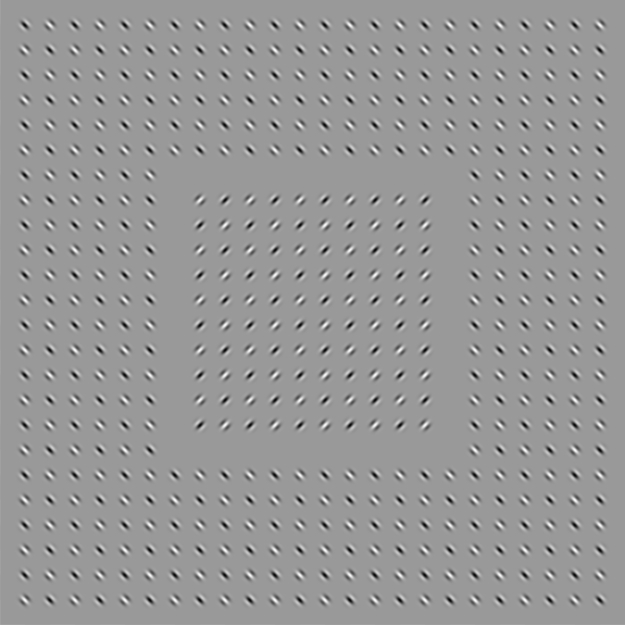
Gabor patch drift illusion (Gurnsey-Morgan illusion)
The inset appears to move.
Drawn by Akiyoshi Kitaoka 2007 (August 8)
<Handout>
cf. Popple illusion (phase-shift illusion)
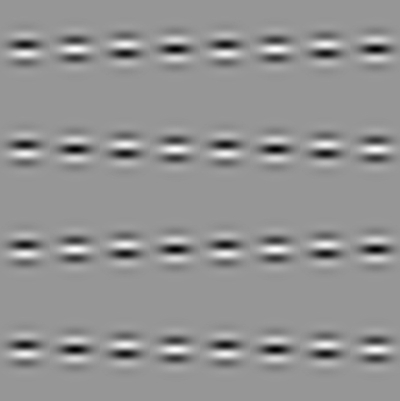
Popple, A. V. and Levi, D. M. (2000) A new illusion demonstrates long-range
processing. Vision Research, 40, 2545-2549.
Popple, A. V. and Sagi, D. (2000) A Fraser illusion without local cues?
Vision Research, 40, 873-878.
5. 遠近法的錯視
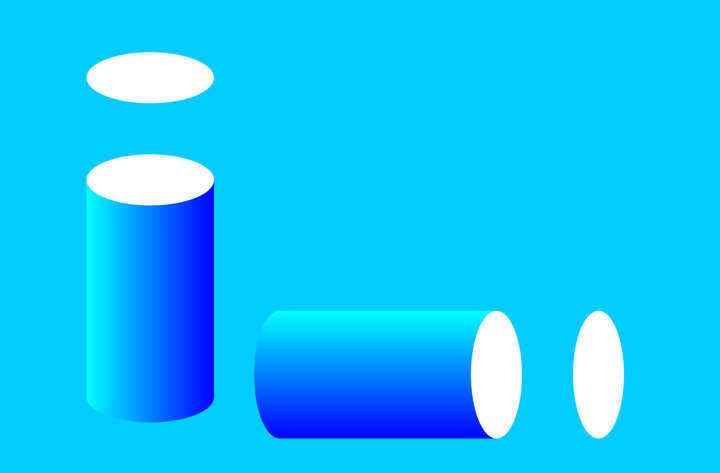
「YPSチューブ」
白い楕円は円筒の上部として知覚されるとずんぐりして見える。逆に言い方をすると、円筒の上部の楕円を切り離して取り出すと細長く見える。
Copyright Akiyoshi Kitaoka 2010 (August 7)
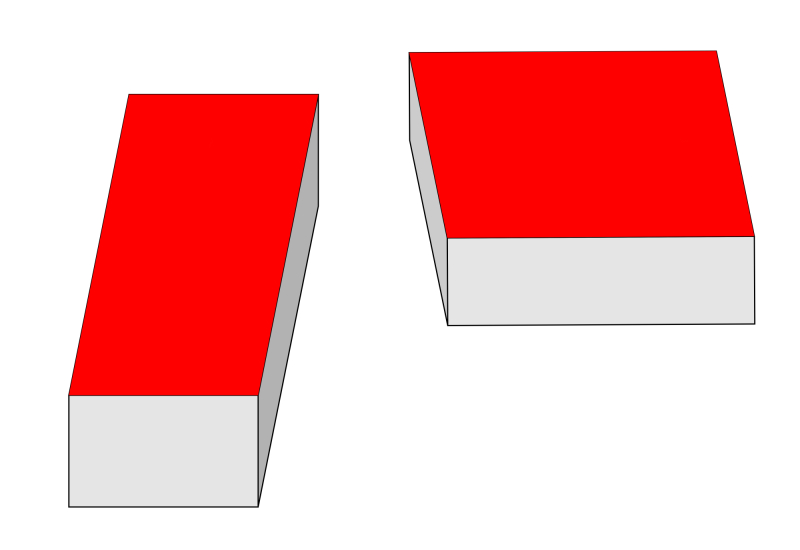
シェパード錯視
(Shepard illusion or table-top illusion)
Shepard, R. N. (1990) Mind sights: original visual illusions, ambiguities, and other anomalies, with a commentary on the play of mind in perception and art. New York: Freeman. (R.N.シェパード著、鈴木光太郎・芳賀康朗訳 (1993) 視覚のトリック:だまし絵が語る「見る」しくみ 東京:新曜社)
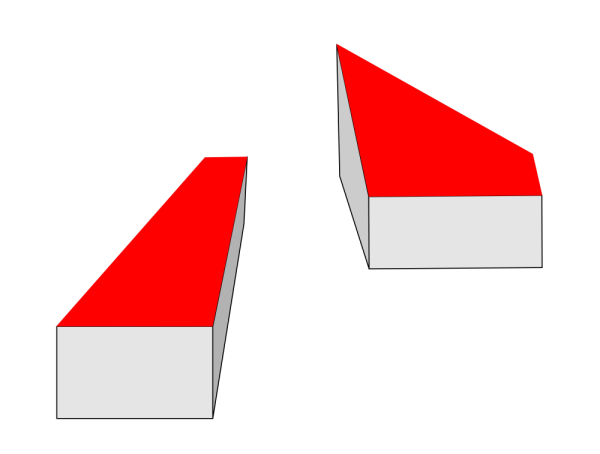
「赤い屋根」 赤い屋根は合同なのであるが、左の屋根は右の屋根に比べて細長く見える。シェパード錯視のバリエーション。
Copyright Akiyoshi Kitaoka 2008 (April 24)
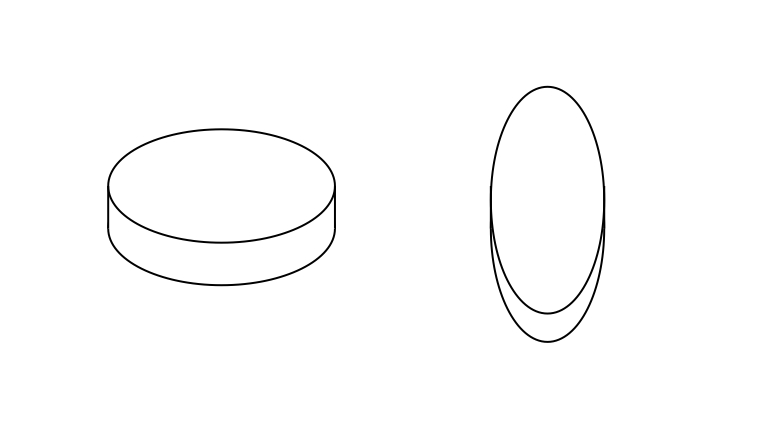
「楕円の錯視」
右の楕円は左の楕円よりも細長く見えるが、同じ形である。
Copyright Akiyoshi Kitaoka 2007 (July 14)
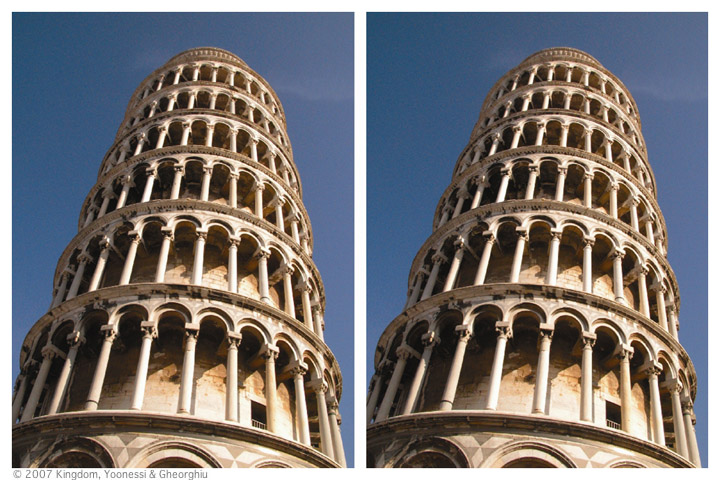
斜塔錯視
(Leaning Tower illusion)
左右の写真は右方向に傾いたように撮影した斜塔であるが、右の写真の傾きが大きく見える(Kingdom et al., 2007)。
Kingdom, F. A. A., Yoonessi, A., and Gheorghiu, E. (2007) The Leaning Tower illusion: a new illusion of perspective. Perception, 36, 475-477.
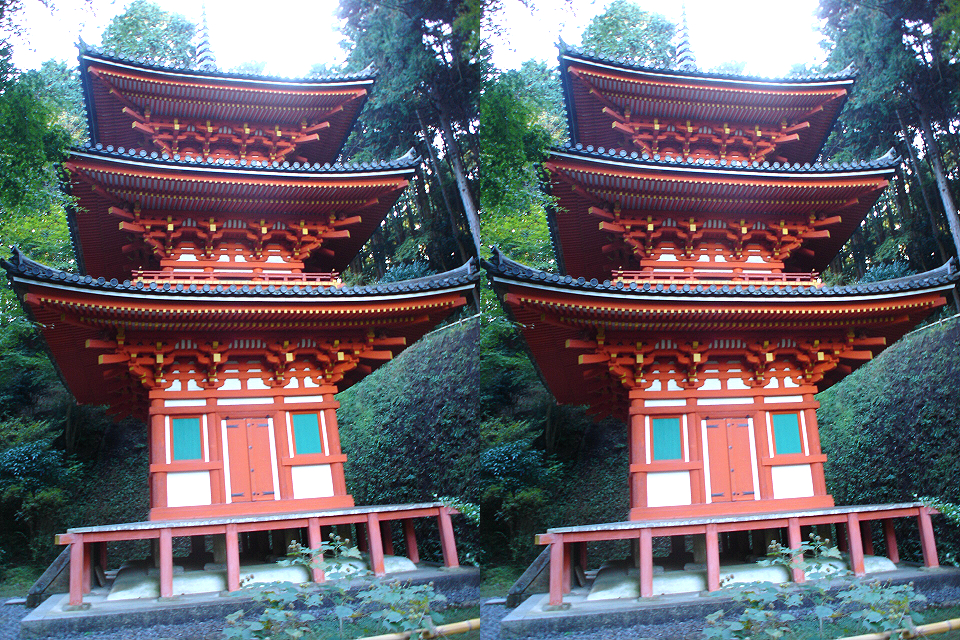
「岩船寺の三重の『斜』塔」
左の三重塔は右の三重塔よりも傾いて見えるが、同じ写真である。
写真は2008年11月12日、fMRI実験の後、K大のA先生(運動残効研究でも有名)と観光した時に撮影
Copyright Akiyoshi Kitaoka 2008 (December 22)
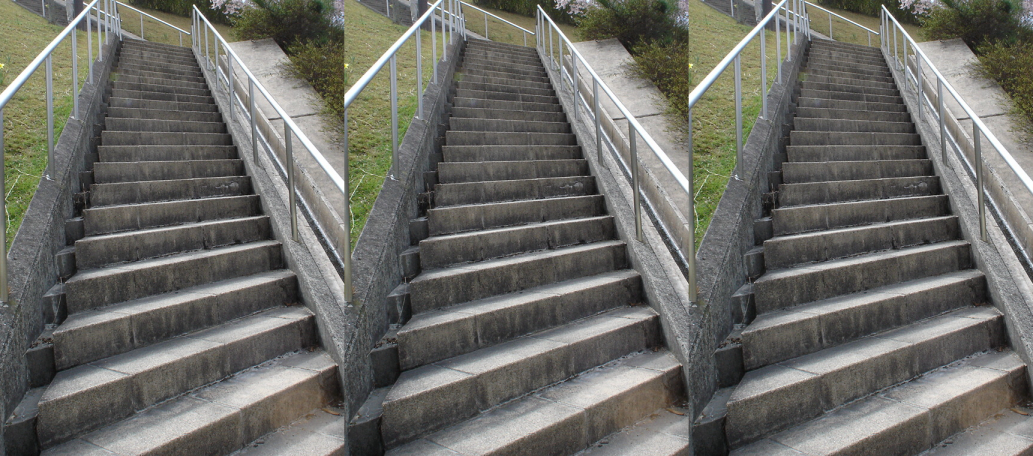
「錯視砦の三錯視」
この図には錯視が少なくとも3種類ある。 (1) 左の階段は左向きに、中央の階段は中央向きに、右の階段は右向きに見えるが、3枚とも同じ写真である。これは、ピサの斜塔傾き錯視(Leaning Tower illusion)(Kingdom et al., 2007)のバリエーションと考えられる。 (2) 階段の下の方は左に、上の方は右に傾いて見える。これは、對梨成一氏のゆがんだ階段錯視(skewed staircase illusion)である。 (3) 階段が上昇するように見える。 (ん、そうは見えない?)
Copyright Akiyoshi Kitaoka 2008 (April 21)
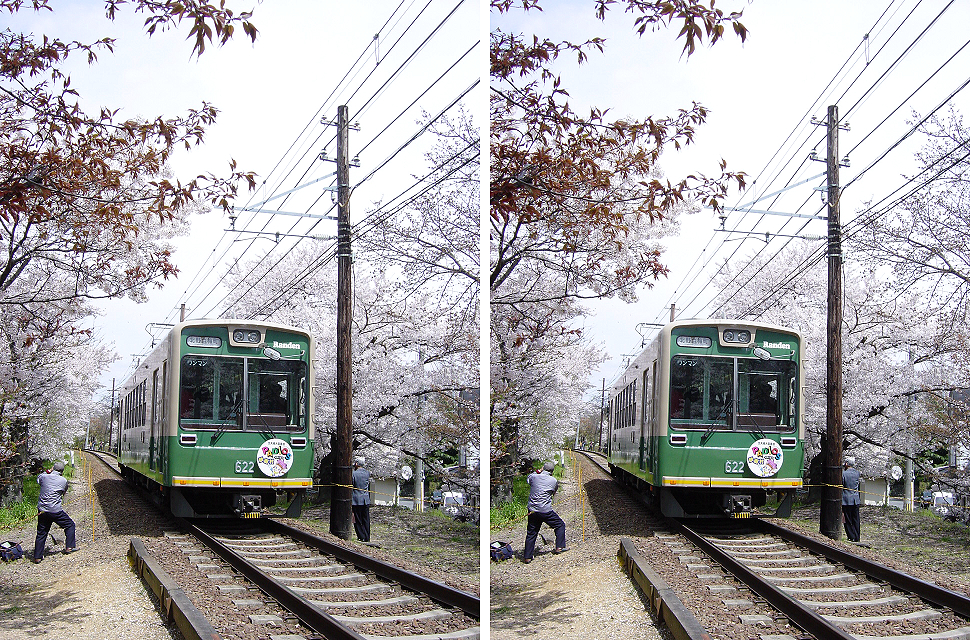
「桜の嵐電」
この嵐電は北野白梅町行きなので、後ろから撮影している。左の嵐電は右に比べてより左の方向に向かっているように見えるが、同じ写真である。
写真は2003年4月10日
Copyright Akiyoshi Kitaoka 2009 (April 30)
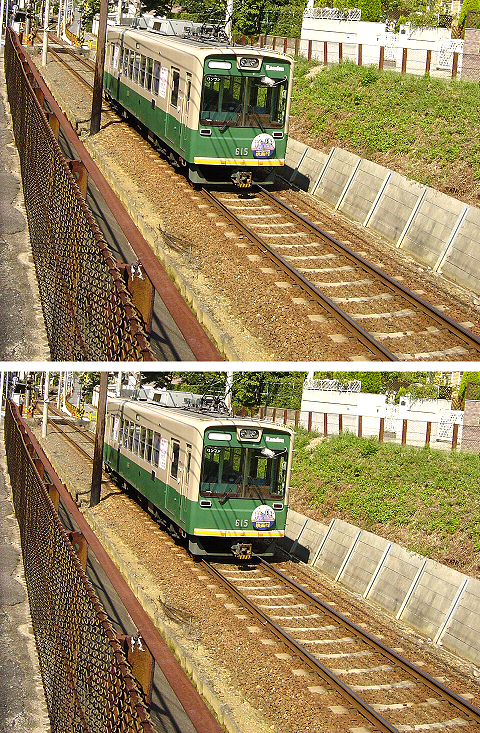
「御室の切り通しの嵐電」
この嵐電は帷子の辻行きなので、後ろから撮影している。上の嵐電は下に比べてより上の方向に向かっているように見えるが、同じ写真である。
写真は2002年9月20日
Copyright Akiyoshi Kitaoka 2009 (April 30)
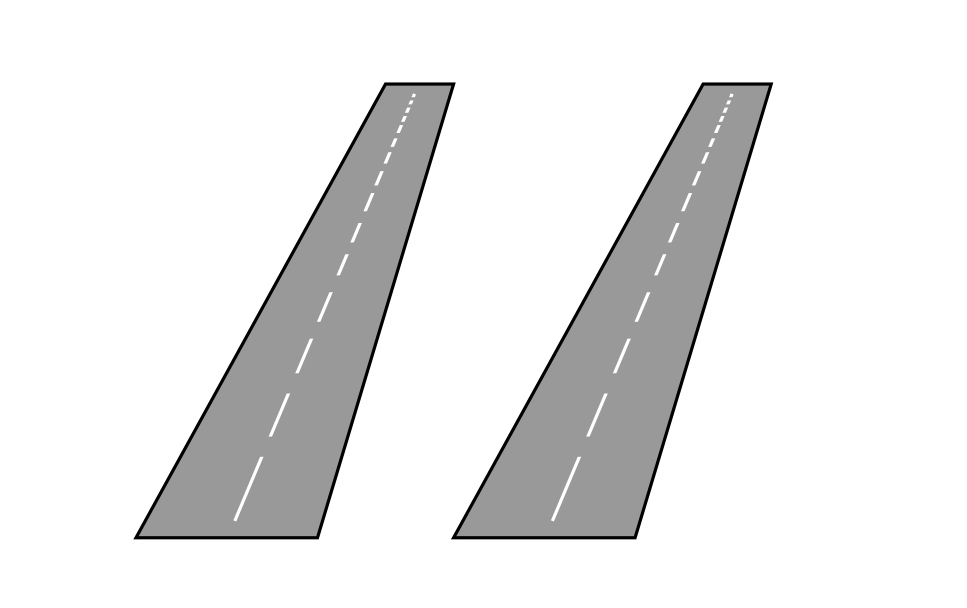
「滑走路」
左右同じであるが、右の方が垂直からの傾きが大きく見える。
Copyright Akiyoshi Kitaoka 2007 (July 14)
ピサの斜塔傾き錯視と同じメカニズム?
「箱傾き錯視」
左右の箱は同じ絵であるが、右の箱の奥は左よりも右に振っているように見える。
Copyright Akiyoshi Kitaoka 2007 (July 14)
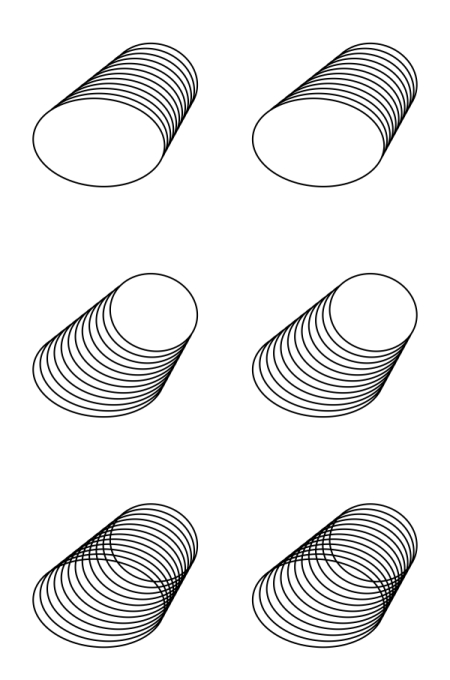
「斜塔錯視反転図形」
開散・収斂の方向が知覚された図の奥行きによって反転する(一番下の図)。
Copyright Akiyoshi Kitaoka 2008 (September 29)
<斜塔錯視は新しいか?>
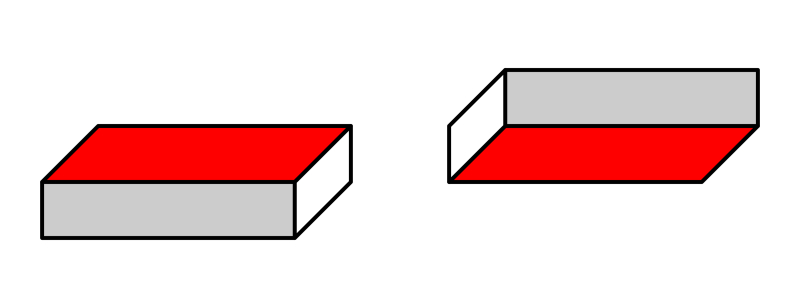
グレゴリーのテーブルの錯視
左右の赤い平行四辺形は同じ形であるが、左の平行四辺形は左辺と右辺は上方に開いて見え、右の平行四辺形は左辺と右辺は下方に開いて見える。
Copyright Akiyoshi Kitaoka 2009 (July 15)
References
"a top-down distortion"
Gregory, R. L. (1998) Eye and Brain, the fifth edition Oxford University Press. (pp. 232)

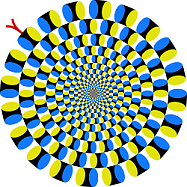 斜塔錯視は基本的にはグレゴリーのテーブルの錯視のようである。
斜塔錯視は基本的にはグレゴリーのテーブルの錯視のようである。
<「後方の過大視」をデモしてみる>
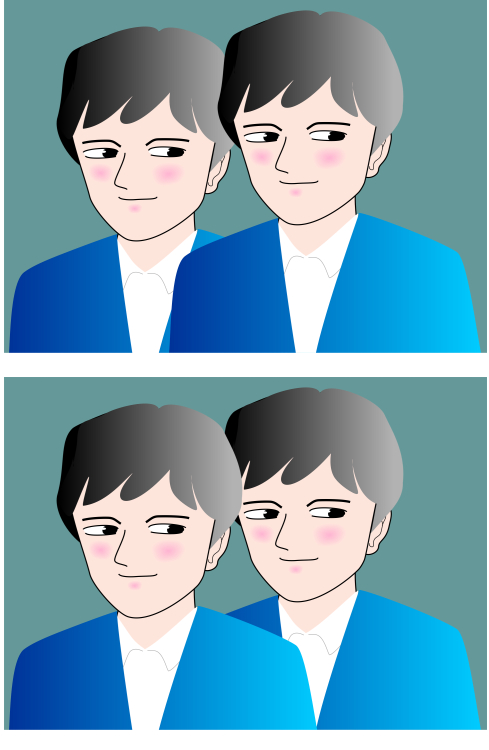
「後ろにいるのがおにいさん」
左右同じ大きさの人物であるが、後方に知覚される人物(上図では左、下図では右)の方が大きく見える。
Copyright Akiyoshi .Kitaoka 2009 (August 22)

「ハム」
左のハムが大きく見えるが、左右同じ大きさに描かれている。
Copyright Akiyoshi .Kitaoka 2008 (July 16)
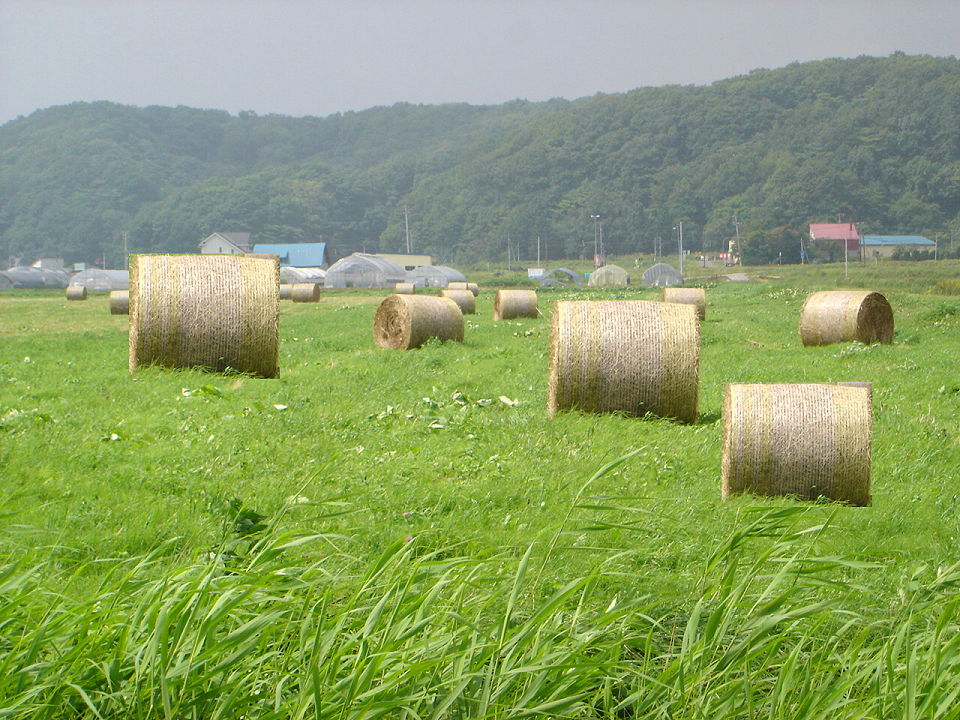
「干草ロール」
3つの干草ロールは同じ大きさであるが、左から大・中・小に見える。
Copyright Akiyoshi .Kitaoka 2009 (August 24)
2009年8月21日撮影
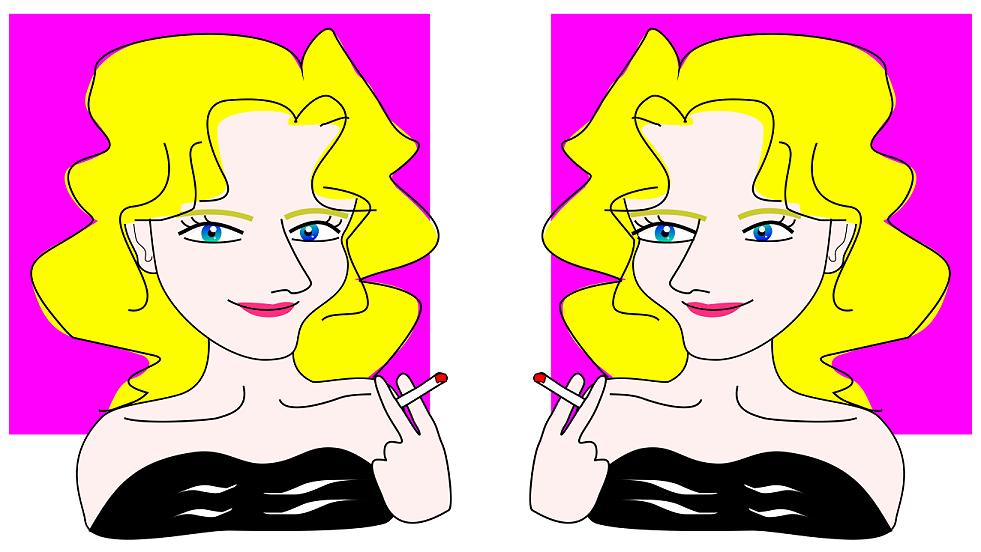
「目の大きさ錯視」
左右の図の両目は物理的には同じに描かれているが、左の図では自然な感じだが、右の図では不自然に右目が小さく左目が大きく見える。
Copyright Akiyoshi Kitaoka 2009 (August 17)
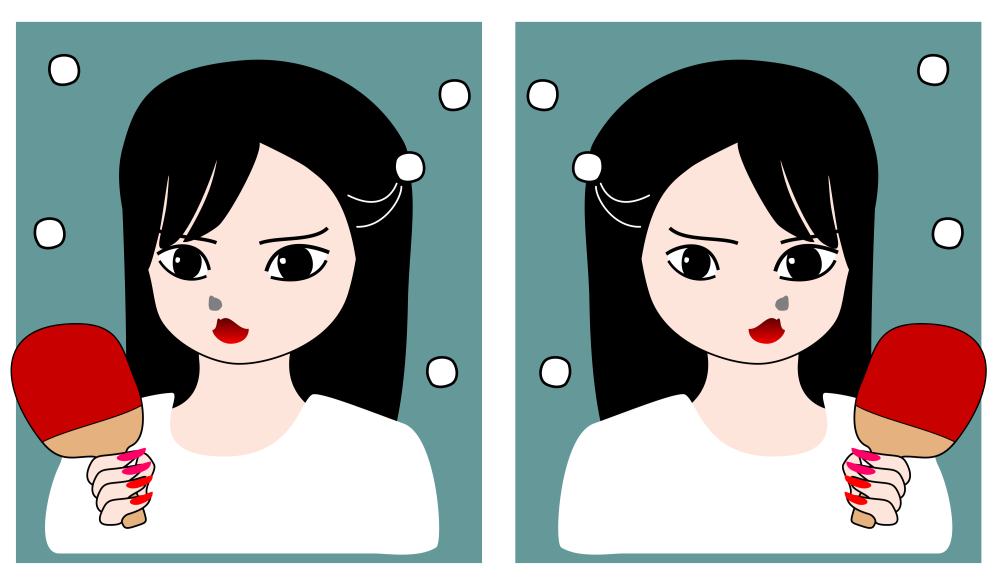
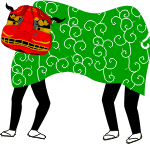 おしまい (The end)
おしまい (The end)
Thank you!
ご清聴ありがとうございました。